 USA (1919) USS Tennessee (BB 43), California (BB 44)
USA (1919) USS Tennessee (BB 43), California (BB 44)WW1 US Battleships:
USS Maine | USS Texas | Indiana class | USS Iowa | Kearsage class | Illinois class | Maine class | Virginia class | Connecticut class | Mississippi class | South Carolina class | Delaware class | Florida class | Arkansas class | New York class | Nevada class | Pennsylvania class | New Mexico class | Tennessee class | Colorado class | South Dakota class | Lexington classThe Tennessee class: last standard dreadnoughts
One of the mightiest class of twelve-gunned battleships in the US navy, the Tennessee class battleships were heavy hitters and rugged survivors. The Tennessee class of battleships were from the “standard series” of battleships laid down in 1910. There were two ships in the class; U.S.S. Tennessee and U.S.S. California. A continuation in many respects of the previous New Mexico class battleships. Improvements added to the Tennessee class were increased underwater protection systems and greater elevation for the guns mounts for greater ranges. The ships of both classes carried the same main battery of twelve 14in (356 mm) main guns split into four turrets, all in the axis and superfiring position for maximal arc of fire. Both also had a top speed of 21 knots. The Tennessee class battleships were the first WW1-era capital ships not to participate to the great war, as they were completed too late. They would spend much of the interwar period as training ships for an extensive training program that was making and refining new doctrines of naval warfare. Both were badly damaged at Pear Harbor and rebuilt entirely to new standards, emerging again to take part in the later pacific campaign.
Design of the Tennessee Class:
The Tennessee class battleship, although a different class, is essentially a repeat of the New Mexico class battleship. This battleship class was often referred to as “Battleship 16” with her design beginning in 1915 and completed in 1916. Their major design feature was the armor design. Tennessee’s basis of design was pulled from the standard-type battleship series. The General Board for the navy wanted originally this class to have a new protection, immune the latest 15-inch guns of the European navies. This, unfortunately, was overruled by the Secretary of the Navy, weary of new spendings and the reaction of the congress. This class would instead be a repeat of the New Mexico class just with minute changes.
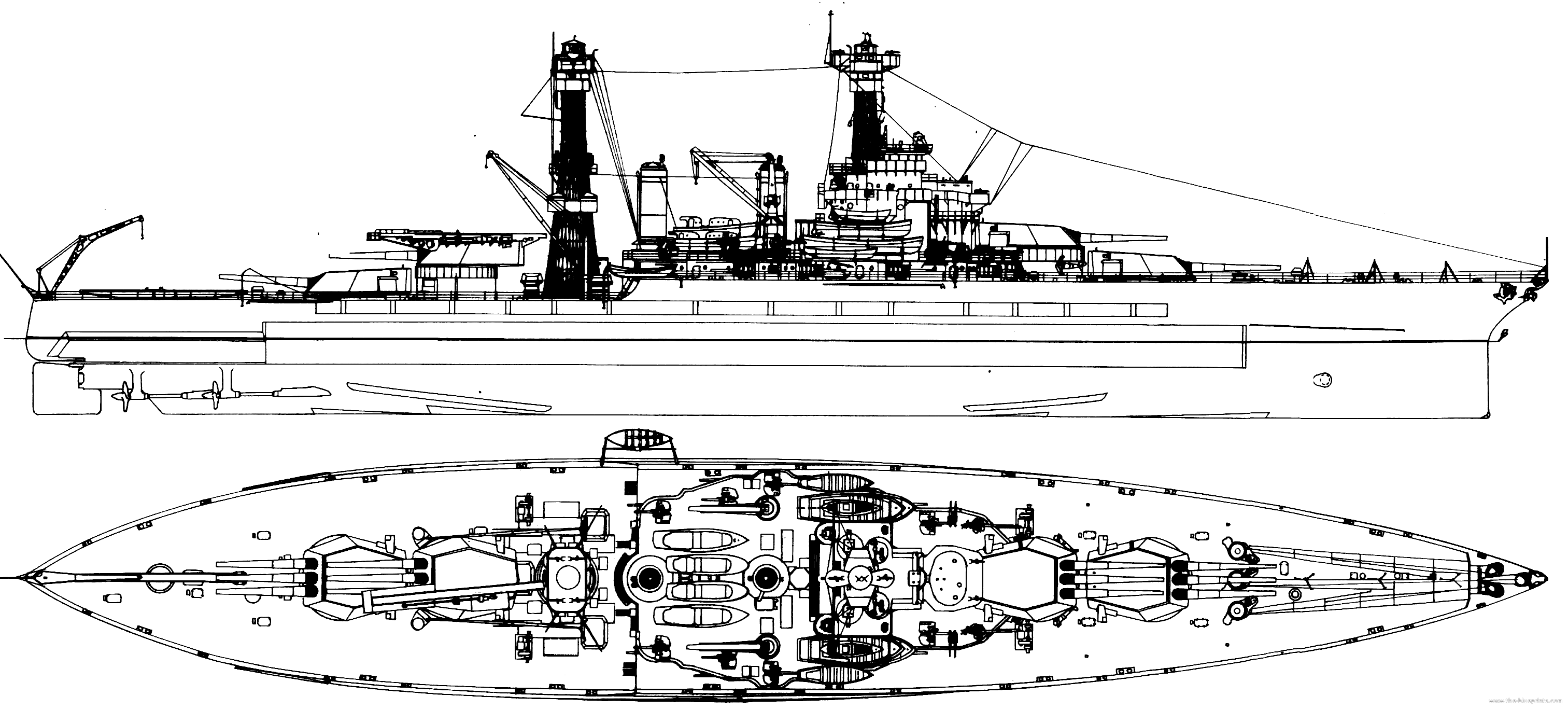
The Tennessee appearance in 1936 (src. the blueprints.com)
By this time, the European powers moved towards larger and longer-ranged guns, the British led the way with their Queen Elisabth series of “super-dreadnought” armed with 15-in (381 mm) main guns. Also another perceived threat from Europe was the development of longer range torpedoes with powerful warheads. This became a major concern for underwater protection and designers decided to add revamped torpedo bulkheads with four voids also to resist underwater mine blasts. The system proved very effective and was retaken in subsequent ship designs.
The blueprints were authorized and Tennessee and California were ordered in March of 1915, however, whereas many aspects of the design was still being refined. Tests for the torpedo bulkheads for example were only completed by February 1916. The Tennessee class proved such an incremental step that the hull was retaken almost without change for the next Colorado class battleship or “battleship 17”. The latter however at last obtained the long-desired 16-in main guns. Their propulsion system was the same also, and it was made ready by December 1916, whereas USS California just was laid down at Mare Island in October that year and her sister-ship at New York NYD in May 1917, quite a large gap.
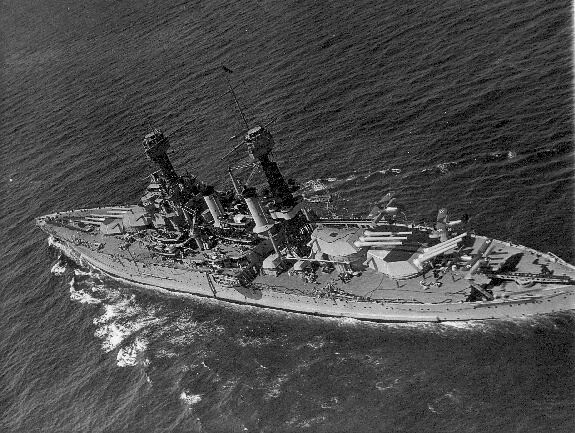
USS Tennessee in 1936, aerial view.
Machinery & Characteristics:
General characteristics
Tennessee and California were 600 feet long at the waterline with an overall length of 624 feet long (190.2 m). The beam was 97 feet (29.7 m) and draft 30 feet (9.2 m). This was the same as New Mexico, the beam dictated by the Panama canal gates, with 20 cm additional lenght and 10 cm more for the draft. They displaced 32,818 tons standard, and 33,723 tons fully laden, that is 200 tonnes more than the New Mexico class. Extra fuel and ammunition in wartime would be stored, raising the displacement to 38,556 tons and increased draft by four feet at 34 feet.
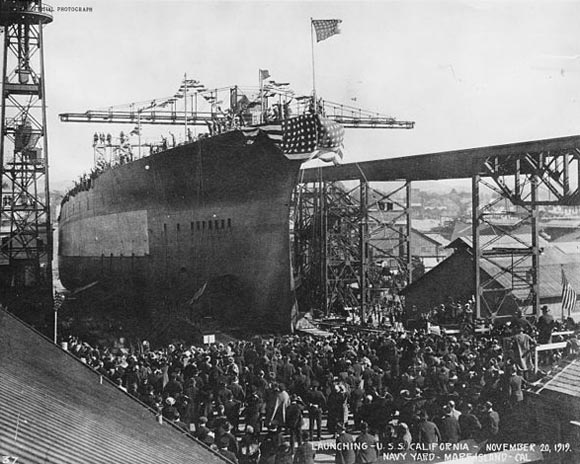
Launch ceremony of USS Tennessee
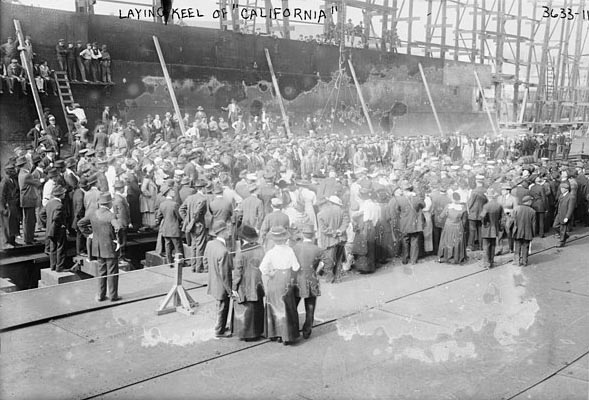
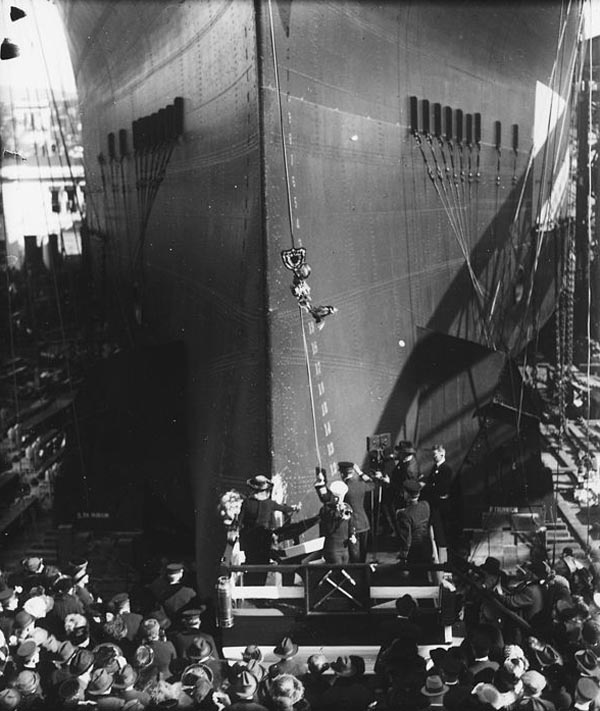

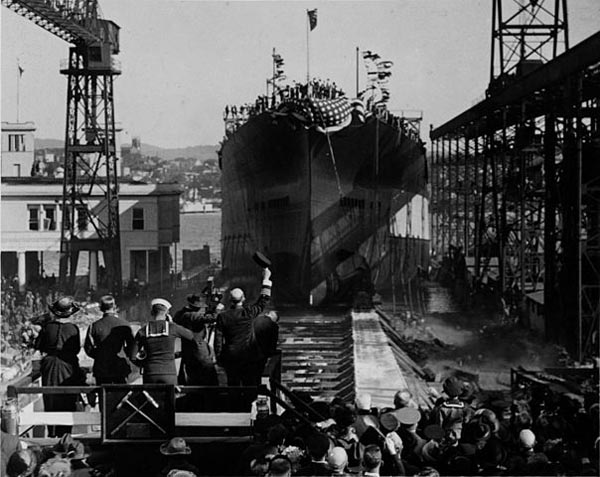
Laying the keel of USS California and launch
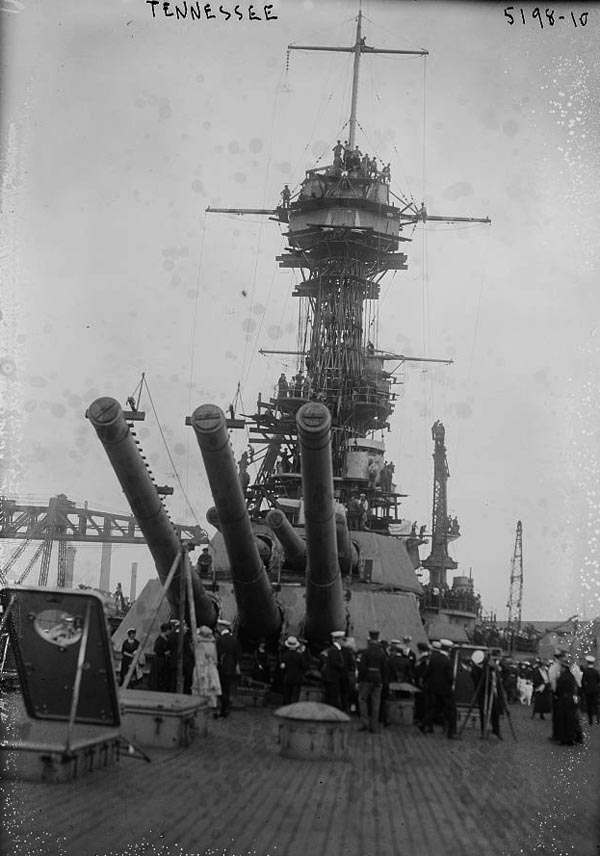
USS Tennessee during completion work
Armament:
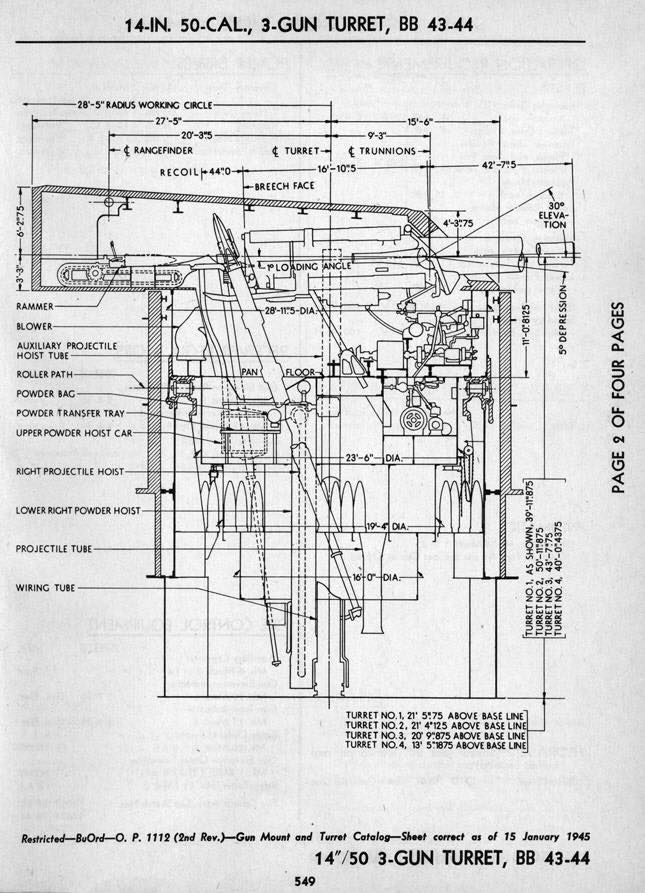
BB-43 turret design
Both Tennessee and California were armed with a main battery of twelve 14-inch (356mm)/50cal. Mark IV guns. These were mounted in four 3-gunned turrets. These were placed in two super-firing pairs fore and aft of the superstructure. This allowed each barrel to independently elevate and depress. During construction, a modification on the turrets allowed the guns to elevate to 30 degrees. This also increased the range of the main guns to almost 20 miles. Excessive dispersion was the only drawback for the guns. It was later discovered that this was caused by overly lengthened chambers which left a gap between the shell and propellant charges. Another 14-inch gun, the Mark VII’s, was the replacement for the Mark IV’s which corrected this problem.
The secondary battery consisted of fourteen 5-inch (127 mm)/51 caliber guns, which were mounted in individual casemates clustered around superstructure amidships at 01 deck level. Six of the guns were arranged to fire forward and four were pointed aft. The remaining four guns were placed in open pivot mounts at 02 deck level; two were placed abreast the conning tower and the other two were placed on either side of the funnels. Later, the secondaries were replaced with 5-in guns mounted in dual-purposed turrets.
Initially, the Tennessee class battleship had only four 76-mm(3-in) 50.caliber Mark X cannons used for anti-air purposes and tertiary armament. These located on the 02 deck of the superstructure with two on each side.
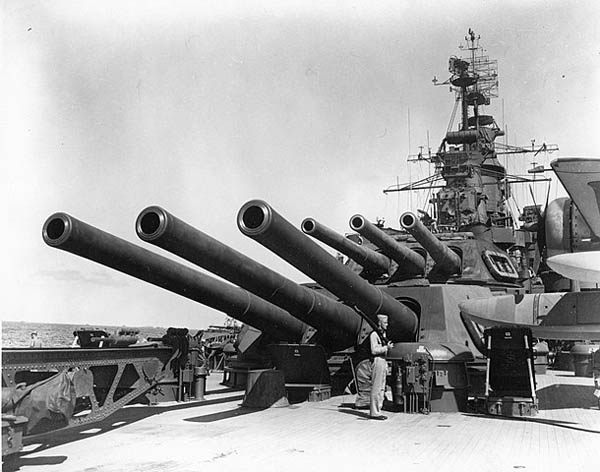
USS California aft turrets
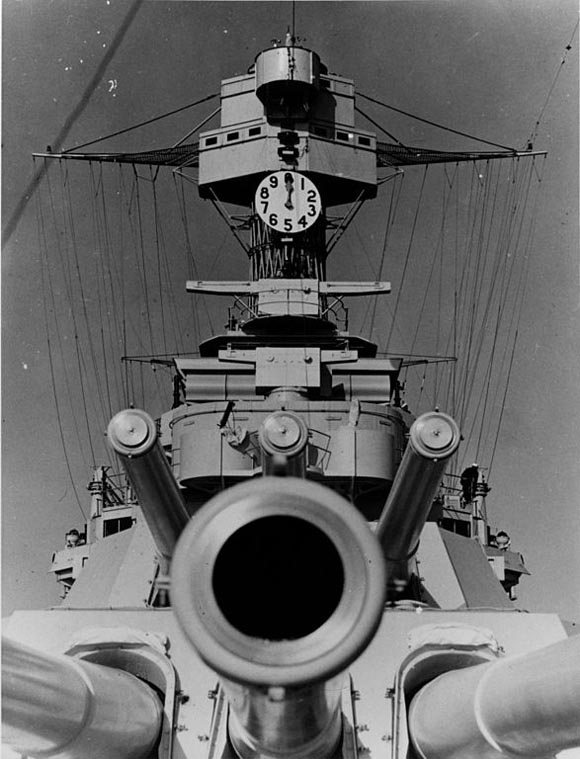
USS California, forward turrets view
Armor Protection
Compartimentation was quite extensive with 768 below the waterline and a total of 180 above the waterline. A double hull was installed to add protection as well as being a solution to extending the hull. The main armor belt of Tennessee and California was 203-343mm (8-13.5 in) thick. The main belt was 18 ft. wide and went down the length of the ship. This protected the boilers, ammunition storages, and other machinery. The bow and the stern received lighter plating which made them easy to penetrate. Both ends of the belt were capped with 343mm transverse bulkheads. This made a forward citadel penetration very difficult. Deck armor was 3.5-in thick and in some areas, attached to the main belt armor. The second deck armor was 2.5-in thick. This was later increased to five inches. The lower deck was up to three inches.
The main turrets were heavily armored. The face of all the main gun turrets was 18 inches(457mm) thick with 10 inch(254mm) thick sides. The rear was 9 inches (229) thick and the roof was 5 inches(127mm) thick. The conning towers had 16 inches (406mm) of armor on the sides and 6 inches(152mm) on the roof.
Main innovation: The electric powerplant
For the second time on an american battleships (or any battleship worldwide for that matter), propellers shafts were driven by electric power. It was not pure, 100% eletric drive however, as the the power required no battery in the world could have procured the needed power in a manageable ship. The system was pioneered on the USS New Mexico, using for the first time General Electric steam turbines fitted with a turbo-electric transmission. This technology was in its early infancy (and arguably 100 years after, not grown a lot). The main two Westinghouse power units indeed were modified steam turbines fed by the steam from eight oil-fired Babcock and Wilcox boilers. This turbo-electric drive was at first intended for the Colorado class, but retroactively applied during construction to the California and Tennesse. That kind of turbo-electric generators were already known by their use in civilian applications, notably barrages. The elctric current could be modulated to play with the drive of each four 3-bladed, 14-foot (4.3 m) propeller screws with ease, and instant reactions.
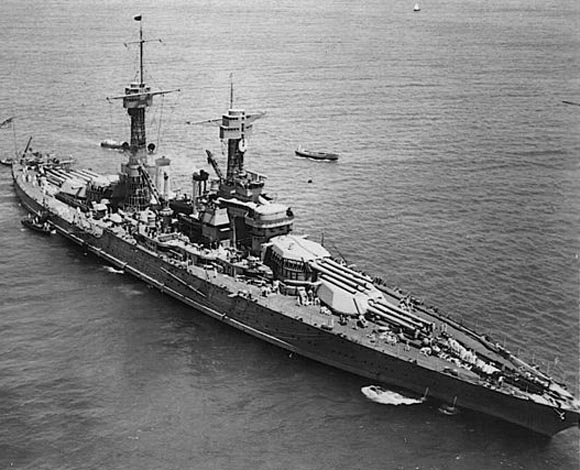
USS Tennessee in the 1920s
The turbines were installed in separate watertight compartments fore and aft. Four boilers were in their own independent, watertight boiler room, with exhausts ducted into their own funnel, and two were placed on either side of the turbines. The motors were located in three sepaarate rooms, a larger central room for the two inboard shafts, and one motor for each outboard shaft, on either side. This propulsion was rated at 28,600 shaft horsepower (21,300 kW), for a top speed of 21 knots. In speed trials in 1919, USS Tennessee reached 21.38 knots (39.60 km/h; 24.60 mph) obtained from 29,609 shp (22,079 kW) in forced heating.
Range: Oil storage was 1,900 long tons (1,930 t) in peacetime. In wartime, voids in the hull could be filled too, for a grand total of 4,656 long tons (4,731 t). This gave the maximal cruising range of 8,000 nautical miles (15,000 km; 9,200 mi) at 10 knots cruise speed (19 km/h; 12 mph). When speeding up to 20 knots, almost their max battle speed, this figure fell to a still reasonable 2,500 nautical miles (4,600 km; 2,900 mi). But this was for peacetime, normal conditions. In wartime with all void filled, this more than doubled, at 20,500 nautical miles (38,000 km; 23,600 mi), still at 10 knots and 9,700 nautical miles (18,000 km; 11,200 mi) at 18 knots, making them ideal for the Pacific. In fact, with the two Colrado, they made the spearhead of the “battleship row” and were well-known and targeted by the Japanese in december 1941.

USS Tennessee (BB-43), 1921
Specifications 1919 |
|
| Dimensions | 190.2 x 29.7 x 9.2 m (624 ft x 97 ft 5 in x 30 ft 2 in) |
| Displacement | 32,300 long tons standard, 33,190 FL |
| Crew | 57 officers, 1026 ratings |
| Propulsion | 4 shafts electric morors, Westinghouse Generators, 8 B&W boilers, 28,600 shp |
| Speed | 21 knots (39 km/h; 24 mph, as designed) |
| Range | 8,000 nmi (15,000 km; 9,200 mi) at 10 knots |
| Armament | -12 x 356mm (14-in, 4×3) -14 x 127mm (5-in, single, casemates) -4 x 76 mm/50 (3-in) -2x 533 mm TTs fixed, underwater (21 in) |
| Armor | Waterline belt: 160–250 mm (6.3–9.8 in), Decks: 40–50 mm (1.6–2.0 in), Turrets, barbettes: 250 mm (9.8 in), CT: 10 in (254 mm) |
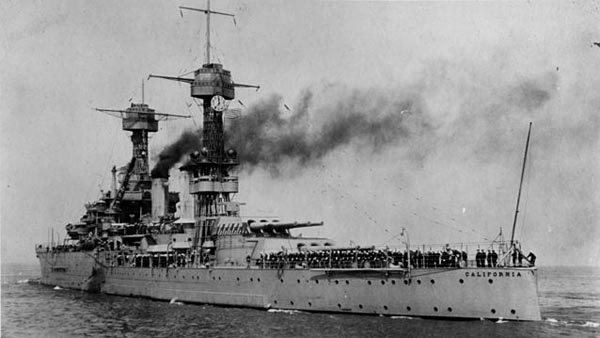
USS Tenessee, stern view, 1921
Interwar service & refits
Modifications history
The Tennessees underwent minor modifications after their entry into service, starting with their secondary armament and AA.
-1922: Tennessee two 5-inch guns were removed (abreast the mainmast), four more 3-in AA guns installed on the main battery deck and behind the forward 5-inch mounts.
-1928: All eight 3-in guns replaced with 5-inch/25 AA.
-1929: California was rearmed the same way during her 1929–1930 refit, gaining also eight .50 caliber machine guns: Six were located on the spotting tops roofs, foremast (2) and mainmast (4) for the best arc of fire. The other ones were placed on pedestals abreast the foremast.
-1930: Installation of aircraft-handling equipment. Catapult for California, aft superfiring turret*
-1932: Tennessee had aviattion facilities installed and her own catapult moved on the fantail (aft deck)
-1934-36: One catapult installed the aft turret (Tennessee) and fantail one for California
-1940: Tennessee obtained two more 3-inch guns installed on the bridge wings.
-1943: Turret-mounted catapult removed for both vessels.
Onboard Aviation
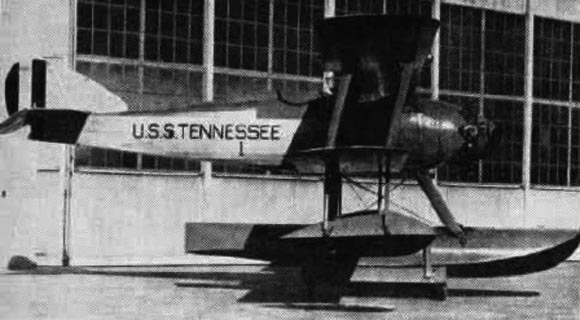
In 1930, California obtained three Vought UO-1 seaplanes, both for reconnaissance and fire direction, also adopted by her sister ships two years after. The biplanes were derived from the land-based Vought FU (1927), derived from a 1926 request from the navy for replacements for the VE-7. The design was the same essentially, but sturdier and fitted with a mich more powerful Wright J-3 radial engine, 9-cyl, which developed 220 hp (164 kW) for a top speed of 106 kn (122 mph, 196 km/h) at sea level, a range of 357 nmi (410 mi, 660 km) and a service ceiling of 26,500 ft (8,080 m). Armament was limited to 2 x .30 in machine guns. The were replaced in the late 1930s by the more capable O2U Corsair biplane (400 hp) and the Curtiss SOC Seagull in 1939, and in late 1941 the OS2-U Vought Kingfisher.
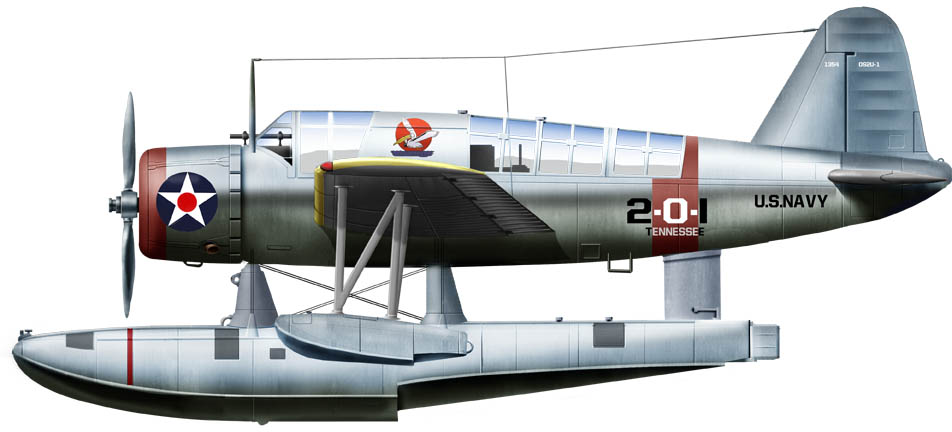
Vought OS2-U Kingfisher of early production, VO-3 Sqn. onboard BB43, December 1941.
Tennessee class service

USS California passing the golden gate bridge in 1939
USS Tennessee and California served in the Pacific Fleet (Battle Fleet in 1922, Battle Force in 1931) for most of their peacetime careers, and California was its fleet flagship. She carried out routine fleet training exercises and annual Fleet Problems, and in-between cruises along the Pacific South American coast, and goodwill visits like one in 1925 to Australia and New Zealand. These fleet problems implicated many ships, logistics and crews, were meticulously planned, and costly, but they provided a sturdy basis for the US Navy’s operational doctrine in the Pacific War. The experience demonstrated notably the standard type battleships were now too slow to follow aircraft carriers. This only underline the need for fast battleships that was first formulated in the early 1930s. Joint training with the Marine Corps also provided a precious experience and already prepared the future “island hopping” campaign by working out many practical aspects of amphibious operations and long range, long duration combined-arms battlefleet deployment. In November 1924, Lieutenant Dixie Kiefer took command of USS California. In 1933 her crew also participated in a relief effort after the earthcake of Long Beach, California.
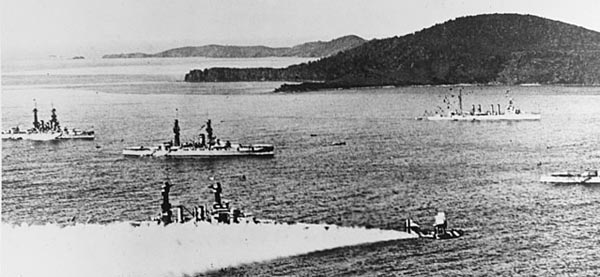
Air smoke dispensal exercize during fleet problem 1924
The war broke out and as tensions rose in 1940 with Japan, following the Second Sino-Japanese War and subsequent developments in Indochina, President Franklin D. Roosevelt ordered the Pacific Battle Force based in San Pedro (California) to Pearl Harbor in Hawaii as a deterrent. Further modernization for the the California class battleships, scheduled in late 1940-41 was cancelled, as well as fleet problem 1941. By late 1941, the navy was maintained in a constant high state of readiness. The attack at Pearl Harbor nevertheless achieved complete surprise and caught the crews and command completely unprepared. As they were anchored in Battleship Row, these ships became easy targets. California was sunk in shallow water but Tennessee moored inboard of the battleship West Virginia, and shielded by the latter, so she was not worried by torpedo but bombs only. Nevertheless, she emerged relatively undamaged, but cause by the heavy fire coming from her neighbours and her forced scrapping to the quay, which necessitated metal work. But overall, this was quickly done and she was of the few ready for the 1942 operations, but the admiralty decided otherwise, and she was completely rebuilt like her sister ship.

USS Tennessee HD profile, Guantanamo Bay trials, March 1921

USS California with her characteristic livery in December 1941

USS Tennessee went to Mare Island for primary repairs, while other escorting Peral Harbor surviving battleships sailed on to Bremertong yards at Puget Sound. Tennessee had prtions of her hull plating and electrical wiring that damaged by fire and replaced. Most importantly, her aft lattice mast was replaced with a provisional tower, carrying the projectors. In place of her .50-caliber machine guns, she received a battery of four quad “Chigaco Piano” 1.1 in (28 mm) mounts fore and aft, and fourteen 20 mm (0.79 in) Oerlikon guns in various places, but kept also her dual purpose 5-in guns on the battery deck. She also had the new Mark 11 14-inch barrels installed, and other modifications. All was was completed by late February 1942 when she departed for her reconstruction (following profiles).

USS Tennessee May 1943, Measure 32v1, design 1D

USS California 1944, Measure 32 Design 16D

USS California in early 1945, early 1945 Measure 21 5-N, dark blue-grey, Navy Blue, measure 20 B on Horizontal surfaces
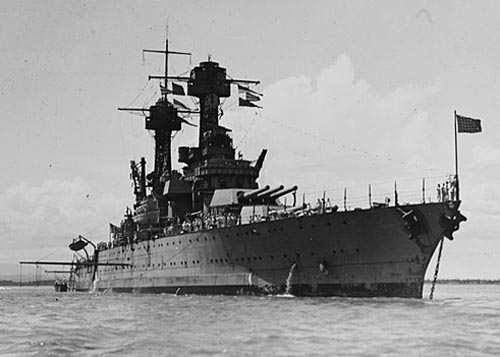
USS Tennessee off Cuba in 1921
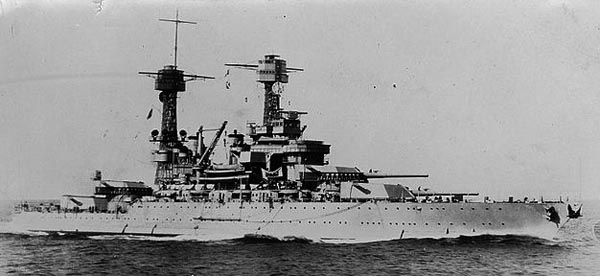
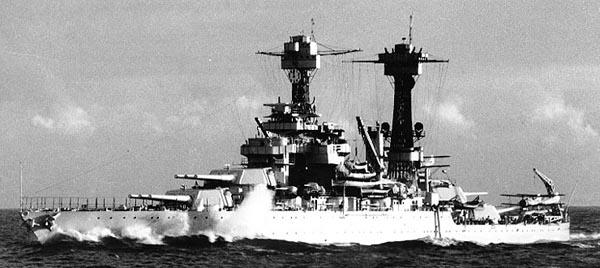
USS Tennessee underway in the 1930s
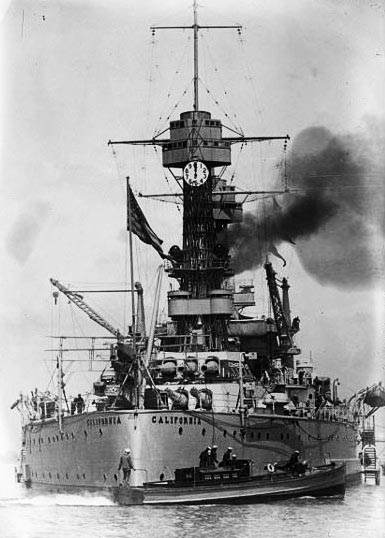
Stern view of USS California
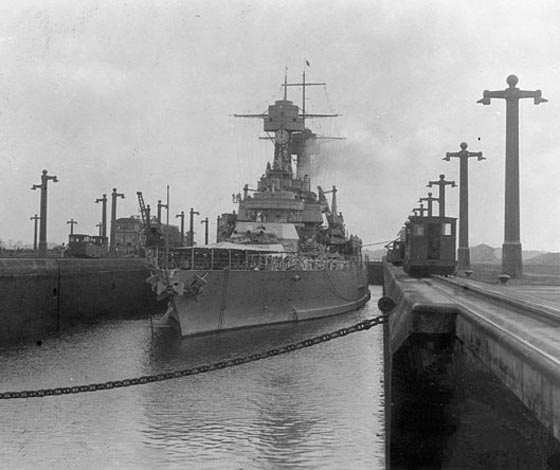
USS California through Gatun locks, Panama canal, 1927
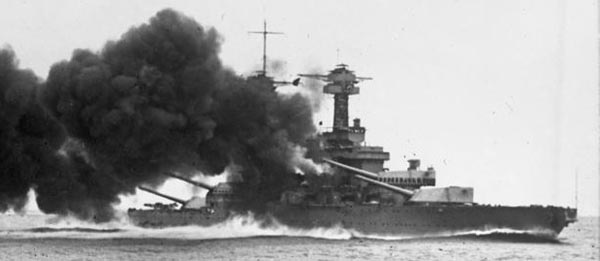
Wartime reconstruction
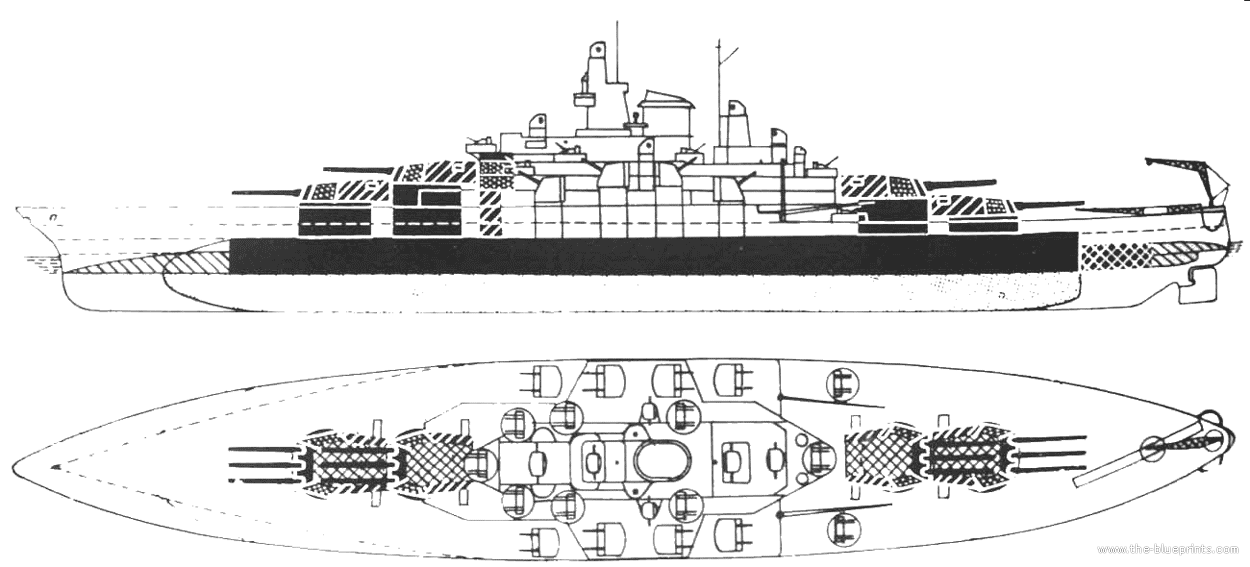
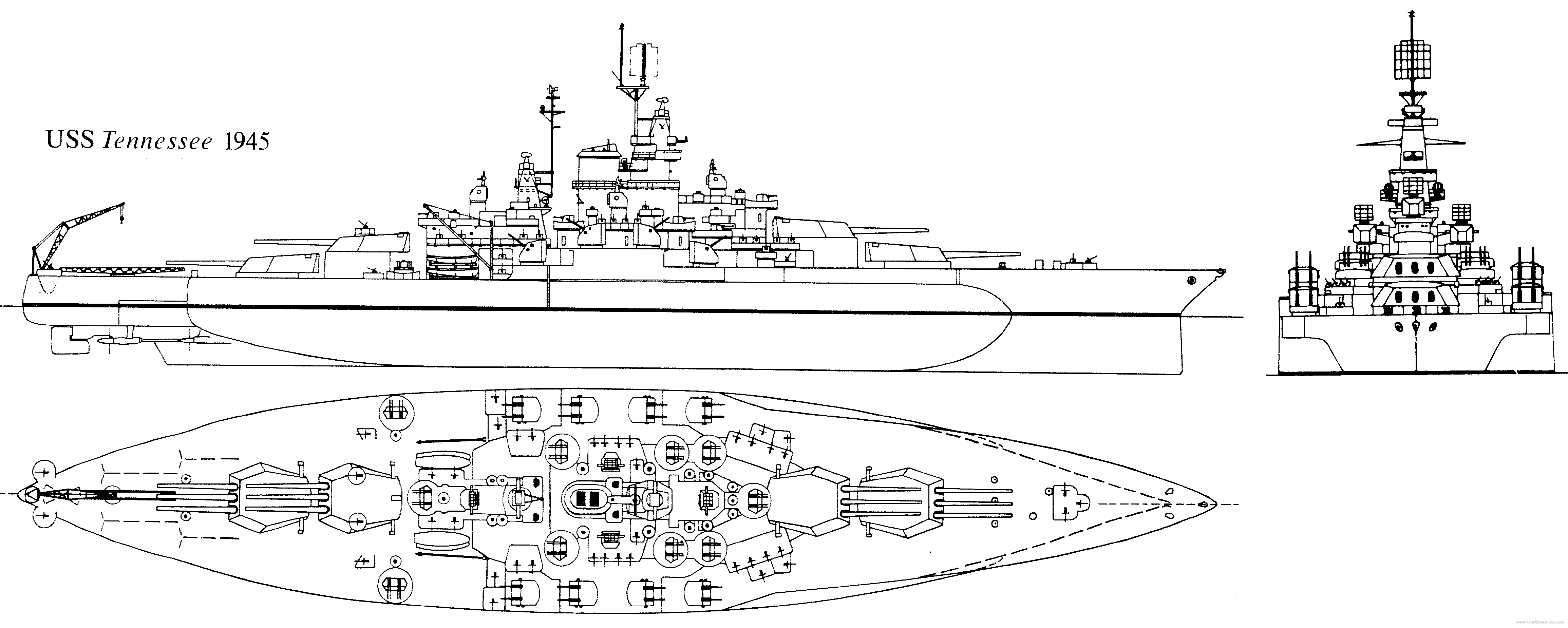
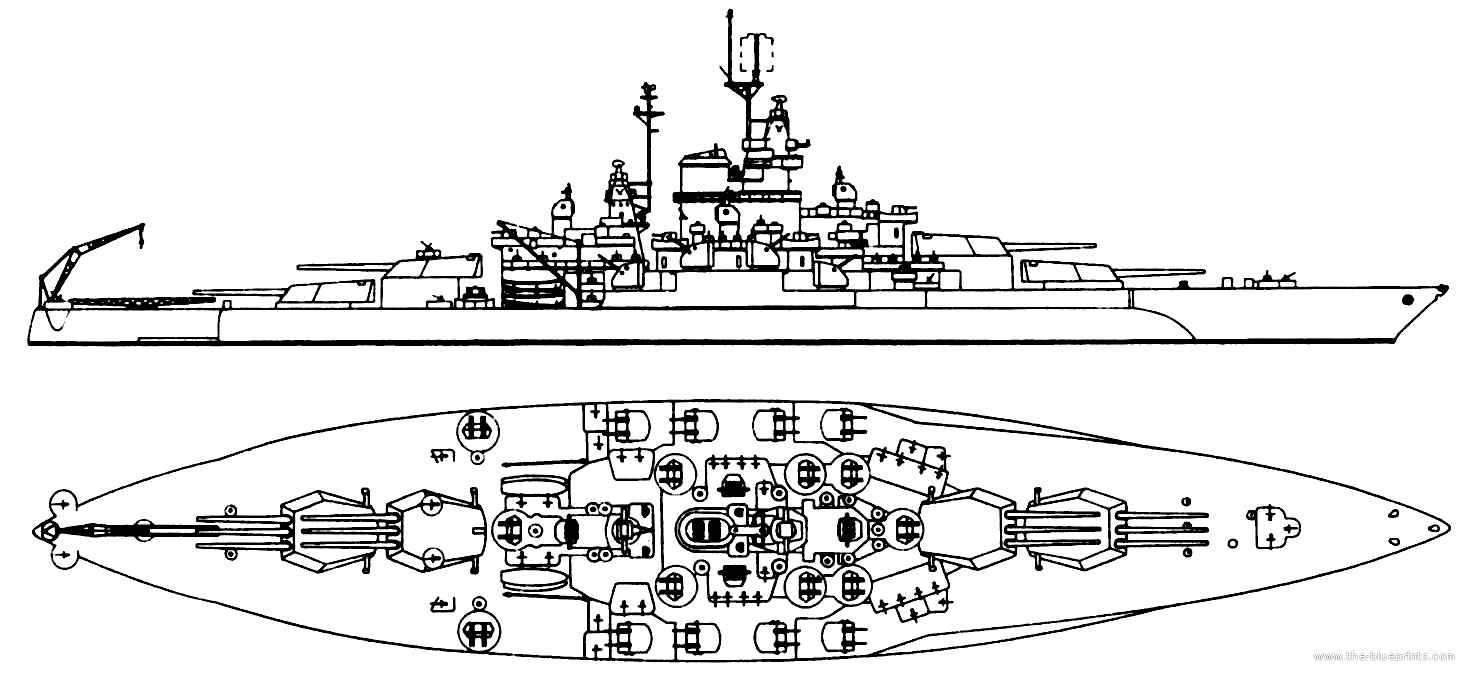
The Pearl Harbor attack, which previously cancelled this reconstruction, just shown how much it was needed, and it was pushed even further out in scale and scope. Both ships were indeed extensively reconstructed and modernized. This reconstruction was a considerable undertaking and a gamble. They could have been patched up, receive a modern radar, modern AA and be sent after just a few months of repairs and fittings, ready for 1942 actions. But this prolonged drydock period had them released only in early 1943, when the Pacific campaign was already turning to the USN advantage, which was claiming the initiative. But they served as prototypes for the reconstruction of later “standards”, the 16-in armed Colorado class, of which only USS West Virginia was rebuilt along similar lines, emerging in 1944. There was some criticism attached to this refit however: Taking these “old hulls” and rebuilding them without modernizing their powerplant meant the added weight of the extra protection, new electric power generator, new twin turrets and superstructure, radars and electronic equipments and AA, were not compensated by a new machinery up to modern standard, compensating for the power ratio loss. The design of her boilers dated back from 1914 basically. We can only assumed all parts of the machinery were revised, cleaned or replaced anew. It is assumed also the top speed stayed the same, at 21 knots. In any case, contrary to the new fast battleships able to be part of the active task forces, these ships were concentrated in their own separate battlefleet division, and took their part in the fighting during many operations where speed was not a factor, in Leyte, where arriving at the right spot what all that mattered, or be stationary for gunnery support during the amphibious operations, and providing AA cover for the Task force to fend-off kamikaze attacks.
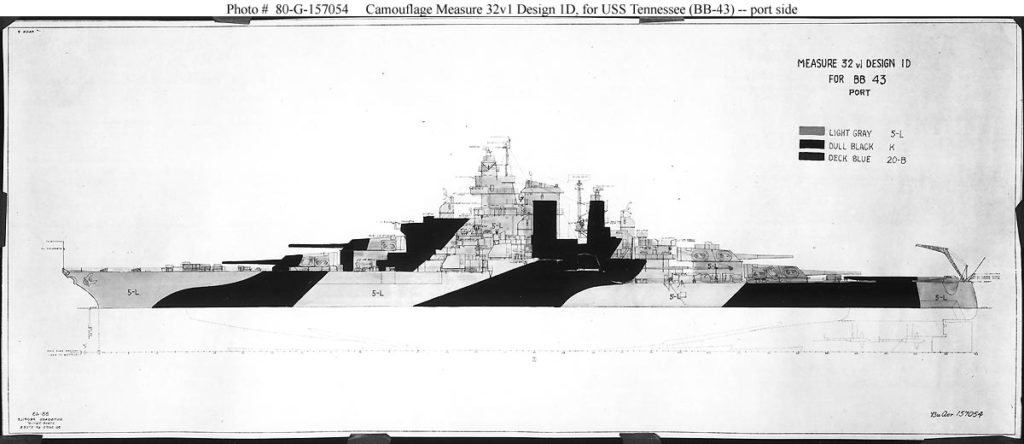
ONI Camouflage measure 32, design 16D – USS California
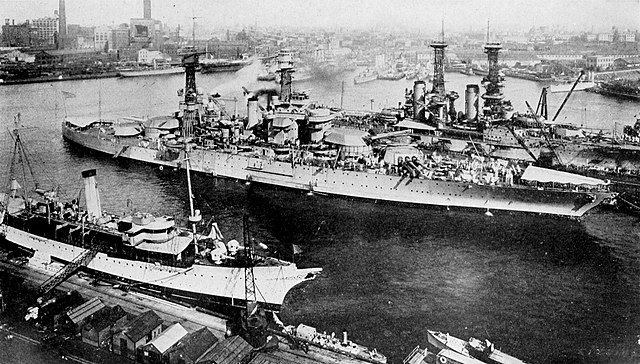
Colliers in 1921 nearby USS Tennessee at Brooklyn Navy yard
Some would argue this conversion was mostly dictated by the war emergency itself, and resources, men and materials could have been reaffected to other ships. Perhaps many high-ranking personal in the USN’s “old guard” insisted in 1942 about their usefulness. Rebuilding these battleships also perhaps had a morale purpose, showing the population at home as well as the Japanese that everything was possible, and these old battleship “sunk” in December were not. Leaving these as they were in the harbor until the end of the war was just inconceivable, notably for practical reason, the quays and equipments were needed for the continuation of the war. Rebuilding these battleships, even at great cost, was proceeding from the main “pearl harbour spirit” which motivated the Doolittle raid over Tokyo in February 1942. It was more about the symbol that for practical reasons. The scrapping and recycling of the whole battleship row could perhaps have been possible under an authoritarian regime, like the USSR, but not in the “arsenal of democracies”. The crippling blow inflicted to the fleet needed to be avenged, and part of it was taking the less damaged ships and took the resources needed to send them modified to the appropriate level for this conflict. And indeed, the five last standard battleships played quite a role in the Campaign of the Pacific, and they certainly earned their citations.
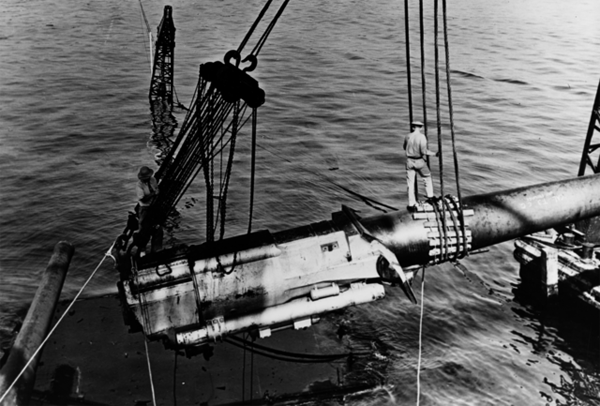
Removal and replacement of USS California’s 14-in gun by the Mark 14 barrels.
We can establish a compelling list for all these points, which also drastically changed their appearance.
-New anti-torpedo bulges
-Internal compartmentalization improved
-Added void space for extra fuel (better autonomy)
-Double hull extended
-All portholes welded shut
-Improvement of the electric power (three time)
-Superstructures completely rebuilt, see the blueprints
-Conning tower removed, small CT (from a Brooklyn class Cruiser) installed
-Foremast replaced by a tower mast housing the bridge, main battery director
-Single funnel with trunked exhaust, embedded in the bridge
-3 inches (76 mm) STS* added over the deck and magazines
-2 inches (51 mm) STS* added on other vital parts of the ship.
-Air-search radar and fire-control radars installed
-Mk.4 14-in barrels replaced anew with Mk.14 barrels
-Sixteen 5-inch/38 in eight twin mounts installed
-4 Mk 37 directors installed for the latter
-10 quadruple 40 mm (1.6 in) AA Bofors guns installed
-42 single shielded 20 mm Oerlikon AA installed
-Crew augmented to 114 officers + 2,129 ratings
-Dimensions: Beam now 34.8 m (vs. 29.7 m), 10.70 m draft
-New displacement: 40,500 tonnes
In 1945 for USS Tennessee: New SP air search radar, Mark 27 fire control radar installed
*special treatment steel
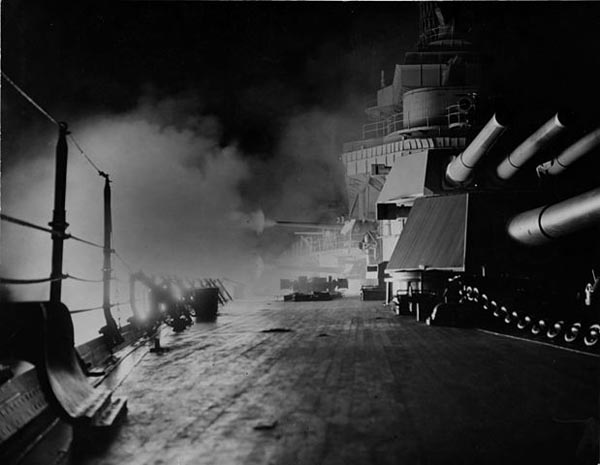
Night firing by USS California
Read more/Src
http://www.researcheratlarge.com/Ships/BB44/PearlHarborDamageReport/
http://www.navsource.org/archives/01/44a.htm
http://digital2.library.ucla.edu/viewItem.do?ark=21198/zz002cpwgd
https://www.ibiblio.org/hyperwar/OnlineLibrary/photos/sh-co-mk/camouflg/usn-wwii/3–bb2.htm
https://weaponsandwarfare.com/2015/08/11/uss-tennessee-bb-43/
Gardiner, Robert & Chesneau, Roger, eds. Conway’s all the world’s fighting ships 1906-21/19922-47
Breyer, Siegfried (1973). Battleships and Battle Cruisers 1905–1970. New York: Doubleday and Company.
Cracknell, William H. (1972). “USS Tennessee (BB-43)”. Warship Profile 21. Windsor: Profile Publications.
Friedman, Norman (2011). Naval Weapons of World War One. Annapolis: Naval Institute Press.
Friedman, Norman (1985). U.S. Battleships: An Illustrated Design History. Annapolis: Naval Institute Press.
Evans, Mark L. (4 May 2017). “California V (BB-44) 1921–1959”. Dictionary of American Naval Fighting Ships. Navy Department, Naval History and Heritage Command.
Gardiner, Robert & Chesneau, Roger, eds. (1980). Conway’s All the World’s Fighting Ships, 1922–1946.
Gardiner, Robert & Gray, Randal, eds. (1985). Conway’s All the World’s Fighting Ships: 1906–1921.
Hornfischer, James D. (2011). Neptune’s Inferno. New York: Bantam Books.
“Tennessee V (Battleship No. 43)”. Dictionary of American Naval Fighting Ships. Navy Department, Naval History and Heritage Command.
Tully, Anthony P. (2009). Battle of Surigao Strait. Bloomington: Indiana University Press.
Smith, Peter C. (2014). Kamikaze: To Die For The Emperor. Barnsley: Pen & Sword Books Ltd. ISBN 9781781593134.
Tully, Anthony P. (2009). Battle of Surigao Strait. Bloomington: Indiana University Press. ISBN 978-0-253-35242-2.
“Update on Pearl Harbor Identifications”. dpaa.mil. Defense POW/MIA Accounting Agency. 6 December 2019. Retrieved 9 January 2020.
Wallin, Homer N. (1968). Pearl Harbor: Why, How, Fleet Salvage and Final Appraisal. Washington, D.C: Department of the Navy. ISBN 0-89875-565-4.
“America’s Biggest Warship Launched”. Washington Times. Washington D.C. 20 November 1919.
Wright, Christopher C. (September 2019). “Question 7/56: Concerning What Radar Systems Were Installed on U.S. Asiatic Fleet Ships in December 1941”. Warship International.
The Tennessee class in Action:
USS Tennessee:
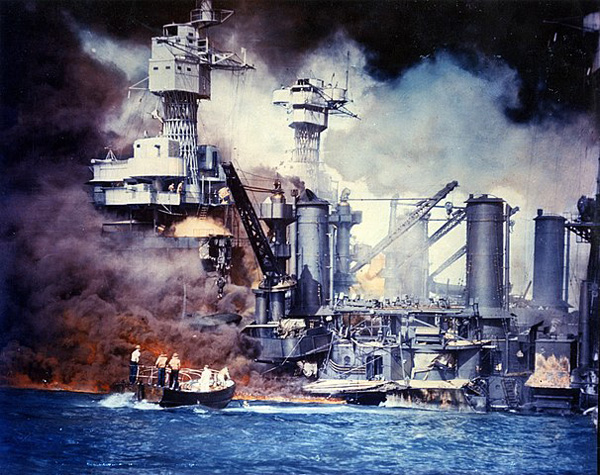
Pearl Harbor attack: Tennessee is behind.
The Pearl Harbor attack
On the morning of December 7th, 1941, U.S.S. Tennessee was docked on the southeastern side of Ford Island in Pearl Harbor, exposed between the island and U.S.S. Maryland in front of her, U.S.S. Oklahoma to her port-bow and U.S.S. West Virginia to her port side (which shielded her) while U.S.S. Arizona was to her stern. At 08:55 hours, the first Japanese bombs and torpedoes were dropped and the crew rushed to battle stations, firing back with 0.5 cal HMGs, while there were delays to get ammo for the 3-in guns, like on other ships. The crew watched U.S.S. Oklahoma torpedoed and capsizing and U.S.S. West Virginia torpedoed and sink, towing her cables with her and forcing the Tennessee against the quay. Japanese fighter planes and dive-bombers started to strafe ships not exposed to torpedoes, Maryland and Tennessee. U.S.S. Arizona’s wild inferno started project burning oil on Tennessee’s stern, added to oil from West Virginia and Oklahoma, surrounding Tennessee and blanketing the water. Both all fire starts were mastered quickly and Tennessee, apart some strafing damage, was spared by bombs as well.
However, the second aerial assault by the Japanese fleet started at 0820 hours. This time, Japanese bombers targeted Tennessee. At last they scored two bombs hit with their converted naval AP shells but both fortunately, failed to detonate properly. The first hit turret #3 and partly penetrated the roof, failing to explode, but sending shrapnels into the turret, disabling the aiming and loading system on one gun. The second hit struck the center gun barrel, on turret two. Fragmentation shot out in all directions, one fragment killing Captain Marvyn S. Bennion of the U.S.S. West Virginia. All three guns were knocked out, however no significant damage was caused internally. The crew managed to flood Tennessee’s magazines to prevent any chances of getting ablaze by burning oil into the propellant storage.
By 10:30 hours, emergency and repair crews had mastered all fires onboard Tennessee but oil fires around would continue to burn for another two days. To move this burning oil mass away, the captain ordered to activate its Propellers to 5 knots (5.8 mph or 9.3km/h). But it only dispersed the floating mass immediately around. The battle led the anti-aircraft crews to claim five confirmed and one assisted air kill.
Damage assessment and refit
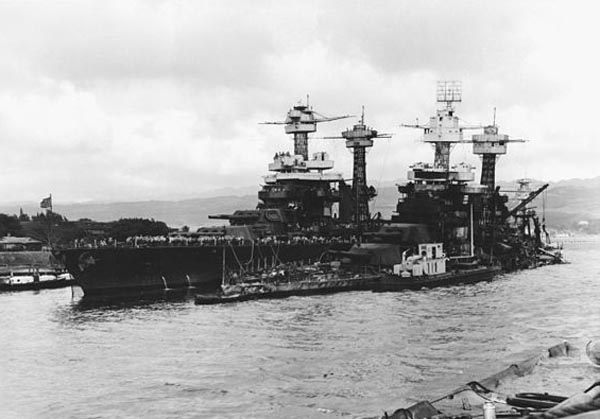
USS Tennessee remained trapped for some time, at least until December 9th, when USS Maryland was freed from her positions between Oklahoma and Ford Island. Quays along Tennessee were dismantled to allow her to be pulled out. Eventually she was freed too, and towed to a drydock for repairs on December 16. Her hull exposed to the other ships had been scorched by oil fires and some plates buckled. The armor plating, seams, and rivets has been weakened by the fire and modified by the extreme heat. The side exposed to the quay had been scratched all along, and some plates badly damaged, when West Virginia pushed her when sinking. An assessment showed she needed full repair before thinking of a refit. Once her hull refitted and watertight, turret three patched up, she was ready to set sail for Puget Sound with Maryland and Pennsylvania, also spared by the attack, escorted by four destroyers.
Once in Puget Sound, USS Tennessee was completely refitted (See above). This concerned the complete renewal of her anti-aircraft artillery, fire control systems, radars, superstructure, secondary artillery, rangefinders and gunnery systems and even her main guns, as her twelve worn-out Mk.4 14-in barrels were replaced by brand new Mk.14 barrels. Her armor comprtimentation and ASW protection was also improved and add-on STS plates welded on all senssitive areas. This refit went on for one year and a half, from December 1941 to late May 1943. Was it worth it ? Let’s check out.
The Alaskan Campaign (Summer 1943)
On May 31, 1943, U.S.S. Tennessee set out on her first mission escorted by U.S.S. Portland. Both ships sailed for Adak in Alaska and met Task Force 16 (Rear Admiral Howard Kingman) with the 2nd Battleship Division. The mission was to cover the assault on Kiska in the Aleutian Islands. Tennessee was tasked with patrol duties, searching for a possible Japanese counter-attack formation. Her radar crews however were still inexperienced at this point and made several false claims of ships through the fog. These unidentified blobs were land masses and moving ice. On August 1st, she was back to Kiska to take part in the preparation shelling, in the fog. She started to obliterate a Japanese submarine base with 60 14-inch shells, relatively accurately despite her Kingfisher spotter planes struggling to spot anything in the fog. Sehe then sailed for Adak to resupply and two weeks later returned to Kiska, this time to cover the invasion force. At 05:00 on August 15, it took place, and she opened fire on Japanese artillery and AA positions, and she was close enough for her 5-in guns to open fire as well, setting an observation post ablaze. After marines went ashore, they mer no resistance as the Japanese had evacuated Kiska in previous July. Mission accomplished, USS Tennessee returned to San Fransico and started there a session of training exercises. Once resupplied, she steamed for Hawaii to conduct more training, and once this second session completed, she headed for the New Hebrides, meeting there the invasion force tasked to retake the Gilbert Islands.
Gilbert island Campaign (Winter 1943)
During this operation in November, USS Tennessee was assisted by U.S.S. Colorado, and both were tasked to provide an intense preparatory bombardment and fire support afterwards, on-demand for the marines. The first assault concerned Tarawa, shere the Marines met a fierce Japanese defensive force. Preliminary bombardments succeeded in blasting away all visible fortifications. But the Japanese beach positions were held on and the defenders pinned down the Americans, too close for comfort if the ships tried to make a direct artillery support. The first night, both battleships could do nothing and were withdrawn to saferty as Japanese submarine attacks were believed imminent. They returned the following morning, mostly to provide anti-aircraft support. Marines still in some case called her for fire support during their difficult advance, and spotter planes did their job well as the weather was fine. They withdrew the following night and the routine resumed on the 22nd of November. A few days later, and the Japanese were pushed back to a small defensive perimeter on the eastern point of the atoll. Marines stopped to let Tennessee and Colorado pounding the area into oblovion for 17-minutes. Tennessee fired in all seventy 14-in salvoes, and 322 5-in salvoes.
At last, at the end of it, destroyers U.S.S. Frazier and Meade spotted the submarine I-35, attacked and forced her to surface. USS Tennessee’s 5-inch joined the fray and pounded the submarine, scoring several hits. In the end, she was finished off by USS Frazier ramming her burning hull, and she sank. On 23 November, the artillery support resumed and USS Tennessee remained until 3 December, as a guardship to prevent any attack or reinforcement until the Marine cleaned up the island entirely. On the evening of 3 December she set sail for Hawaii. There, she mer on 15 December USS Colorado and Maryland and all three departed for San Francisco. There, she was painted with a brand new dazzle camouflage (see the ONI plate) and resumed extensive bombardment training, on 29 December.

Gilbert-Marshall island Campaign, early 1944
Attack on Roi-Namur (January 1944)
On 13 January 1944, USS Tennessee departed for Hawaii, as part of Task Unit 53.5.1. She arrived off Maui on 21 January and was visited there by James Forrestal, Undersecretary of the Navy. On 29 January TU 53.5.1 sailed to the Marshall Islands and arrived in the Gilbert Islands, prepared to attack specifically the Island of Betio, the linchpin of the Japanese defense in the area.
The ships were prepared for the assault on Kwajalein Atoll on 31 January. Tennessee was assisted by USS Pennsylvania and two destroyers. Tennessee was Rear-admiral Kingman’s flagship for the bombardment group; which moved into positions 2,900 yd off the atoll’s Roi-Namur islands. Kingfishers were launched at 06:25 and when the first target was identified and located, fire commenced at 07:01. Pillboxes and fortifications were quickly blasted away, but soon the sky filled with Japanese attack planes coming from a nearby carrier.
Intense AA fire started and Tennessee also silenced Japanese AA batterie. Her support stopped at 12:00, and she turned away, recovering her floatplanes to refuel them and later taking back her firing position. Roi-Namur were pounded until 17:00 when she withdrew to join the escort carriers for the night. During this first day, marines went ashore on nearby five smaller islands, secure passage into the lagoon. Minesweepers also cleaned up the entrance. Tennessee, Colorado, escorted by USS Mobile and Louisville then entered the attoll and took their bombardment positions, east of Roi-Namur, on 1 February 1944. Fire commenced at 07:08 and the marines landed later this morning, soon joined by reinforcement around 12:00. Support Fire went on, and Roi was capured, but Namur held on to fall the next day. On 2 February, Vice Admiral Raymond Spruance and Rear Admiral Richard Conolly came aboard and meet with Forrestal, and later landed to inspect the battlefield.
Attack on Eniwetok (February 1944)
After the Kwajalein Atoll was secured on 7 February, preparations were made to attack in turn the Eniwetok attoll, further west. Tennessee went to Majuro in the Marshalls to replenished fuel and ammunition and was back to start operation on 15 February with Colorado and Pennsylvania. They arrived on 17 February and started the initial shelling while minesweepers cleared the channel, and At 09:15, troopships approached the island of Engebi, first step in the attack. Nearby islets were taken to be converted as field artillery fire bases. Tennessee also used her secondary battery to help Marines setting marker buoys to guide the assault planned for the 18. That day, the preliminary bombardment of Engebi started for Tennessee at 7:33 while marines landed at 08:44. The island fell that day and next Eniwetok and Parry Island were attacked. On 18 February, Tennessee was anchored 5,500 yd (5,000 m) from Eniwetok for the shelling, and fired star shells during the night, helping Marines to spot Japanese infiltrators. She moved next to support the landing on Parry Island with Pennsylvania on the 19, anchored just 900 yd (820 m) from the beach. On 22 February, she was close enough for her 40 mm gunners to open fire on demand on remaining Japanese defenses. The island’s garrison fell that day and Tennessee departed for Majuro, meeting there USS New Mexico, Mississippi, and Idaho.
Attack of Bismarck archipelago (March 1944)
Tennessee and the three New Mexico-class battleships departed on 15 March with two escort carriers and fifteen destroyers. This Task Force targeted Kavieng (northern New Ireland) in the Bismarck Archipelago (Operation Cartwheel). The grand plan was to neutralize and encircle the major Japanese base at Rabaul. Kavieng attack was a diversion, while a marine force landed on Emirau and an airfield built. Operations started on the morning of 20 March 1944, marred by poor visibility, rain squalls and low clouds. The battleships closed to 15,000 yd (14,000 m) and opened fire at 09:05, while still moving at 15 knots. But spotting targets was difficult. Tennessee was fired upon by a coastal battery when she was 7,500 yd (6,900 m) close, and replied with her secondary guns. She was straddled several times and sped up to 18 knots and then opened the range. She silenced the artillery battery and later sailed off Kavieng, shelling positions for another three hours. At 12:35 they withdrew while Emirau fell. Tennessee was ordered back to Pearl Harbor via Purvis Bay and Efate, and arrived on 16 April started her maintenance time.
Mariannas-Palau campaign (May-September 1944)
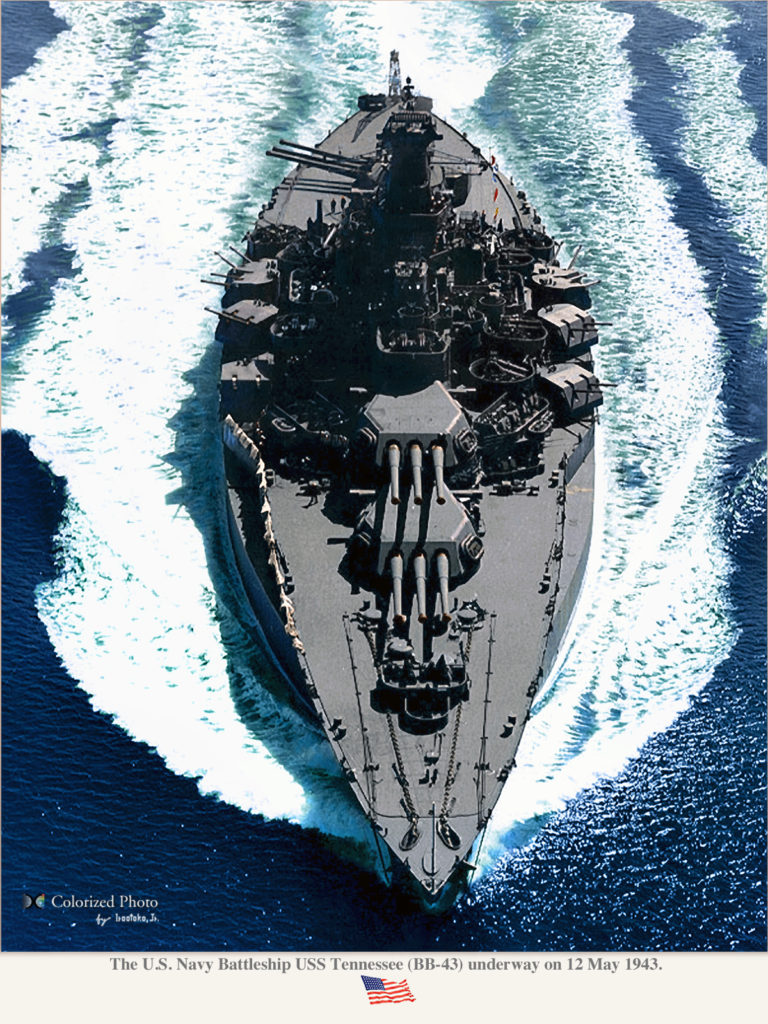
USS Tennessee underway in may 1944 – colorized by Irootoko Jr.
Battle of Saipan
Operation Forager saw USS Tennessee committed in the invasion of the Mariana Islands. She was part of Task Force 52 attacking Saipan and Tinian,while TF 53, would attack Guam. Tennessee was in the bombardment group Task Group 52.17 (Rear Admiral Jesse Oldendorf) in company with USS California, Maryland, and Colorado. TF52 was assembled at Hawaii in May 1944, making exercises off Maui and Kahoolawe before sailing to the Marshalls, arriving on 10 June, and off Saipan on 14 June. Bombardment commenced at 05:39 while minesweepers cleared lanes for the landing crafts. Tennessee also engaged Japanese artillery batteries on Tinian that hit California and the destroyer Braine. night fell and the invasion started the following day, Tennessee firing with her secondaries and 40 mm batteries at 3,000 yd (2,700 m). Fired ceased at 06:30, then restarted from 07:00 to 08:12, Tennessee staying off the southern end of the landing zone. She was targeted by a Japanese 4.7 in (120 mm) field gun hidden in a cave but she took light damage and a fire broke but was was mastered, which left 8 Kia and 25 wounded. She withdrew later to make temporary repairs and repelled four IJN dive-bombers attacking the fleet during the evening. She resumed her fire support until 17 June, but the fleet broke off to face an appoaching fleet. The latter were defeated by Spruance’s carrier force (Battle of the Philippine Sea). After a refuel/resupply stop at Saipan on 20 June she resumed her support until the 22 June, sailing to Eniwetok to be repaired by USS Hector.
Battle of Guam-Tinian

USS Tennessee bombarding Guam in July 1944
In Eniwetok until 16 July, she sailed with California to join TG 53.5, prepared for the invasion of Guam. Operations commenced there on the morning of 20 July, joining the bombardment started twelve days before. TG 53.5 vessels pounded IJN defenses the next day and convered the landings. USS Tennessee withdrew to Saipan on 22 July to replenish her ammunition and was prepared to attack Tinian next. She arrived the next morning and shelled the southwest coast. She withdrew for the night and returned on 24 July, shelling the northwest with California, Louisville, and destroyers, from 2,500 yd (2,300 m) away until the marines assaulted the beach. This went on until 26 July, both battleships landing 480 main rounds 800 secondaries on the island. Tennessee resupplied to Saipan on 27 July and was back on the 28, then returend on 29 July, back on the 30th. She had one of her Kingfishers colliding with a Marine OY-1 spotting plane (both lost). On 31 July, 08:30 USS Tennessee ceased firing, departed for Saipan, and Guam, where she provided support until 8 August.
Battle of Anguar
Tennesse sailed with California and Louisville for Eniwetok, and Espiritu Santo (New Hebrides) arriving on 24 August. She sailed to Tulagi, coverinf an amphibious assault training. Then she was prepared for the reconquest of the Philippines. Her first target were the Kossol Roads, used as a staging area. She would be sent to Peleliu and Anguar next, and arrived on 12 September. The group comprised also Pennsylvania, four cruisers, and five destroyers. The bombardment started at 06:32 from 14,000 yd, down to 3,750 yd and her 40 mm AA guns opened fire in turn. She also tried, but failed, to destroy a large stone lighthouse used as an observation post. The hammering went on for five days while Minesweepers cleared channels. On 15 September, Tennessee was sent to provide fire cover on Peleliu during the assault. She was back to Anguar on the 16, resumed her bombardment, and the cruiser Denver finished off the lighthouse she was set to destroy. On 17 September, she covered the 81st Infantry Division landing, and stayed for two days. It was all over on 20 September and Tennessee was back to Kossol Roads to replenish and on 28 September, departed for Manus island (Admiralty Islands) in preparation for the Philippines campaign, now under Rear Admiral Theodore E. Chandler as the commander of Battleship Division Two.
Philippines campaign (late 1944-summer 1945)
Battle of Leyte
Tennessee started her voyage to the Philippines on 12 October with the 7th Fleet (Vice Admiral Thomas Kinkaid) which carried two Army corps to be landed on the eastern coast of Leyte island. Tennessee, California, and Pennsylvania were to take positions at Dulag, as part of Oldendorf’s bombardment group, the latter keeping his other battleship as a distant cover. Minesweeper started clearing the entrance of Leyte Gulf on 17 October. On the 18, Oldendorf sent his force into the gulf at slow speed until they took their bombardment positions on 19 October, and fire started, until nightfall, withdrawing to a safer position outside the gulf. The bombardment started the next day while troops started to land at 10:00, the battleships swapping to support fire, disrupting Japanese counterattacks and clear the advance. Operation Shō-Gō 1 meanwhile get the greenlight. This complicated counter-attack involving four separate forces was aiming at the Allied invasion fleet. Tennessee was more busy meanwhile with AA fire than actual artillery support as defense was light. On the night of 21 October, the transport USS War Hawk accidentally rammed USS Tennessee, hidden inside a smoke screen. The battleship only had light damage and operations went on until 24 October, with an alert and readiness order.

Battle of Surigao Strait
On 24 October, reports of the IJN approaching the area had Oldendorf scrambling his battleships for action, and direct them at the exit of the Surigao Strait to wait. He has six battleships escorted by eight cruisers and and twenty-eight destroyers. Opposing him, Vice Admiral Shōji Nishimura’s Southern Force was closing through the Surigao Strait with Battleship Division 2 (Yamashiro, Fusō, Mogami, four destroyers) and following closely, Vice Admiral Kiyohide Shima’s 2nd Striking Force (Nachi, Ashigara, Abukuma, four destroyers). Nishimura’s flotilla was attacked by PT boats during the night of 24 October and the Battle of Surigao Strait started. US destroyers torpedoed Fusō but Nishimura went on, until lookouts on Tennessee spotted the distant flashed of the attacking destroyers. At 03:02, Tennessee’s search radar picked up the formation at 44,000 yd (40,000 m). Oldendorf waited until giving the order to opn fire at 03:51. West Virginia barked first, followed by Tennessee and California. All three targeted Yamashiro and Tennessee fired six-gun salvos only in order to save ammunitions, but they made short work of Yamashiro and Mogami, in effect “crossing their T”. At 04:00, Mogami and Yamashiro retreated with the destroyer Shigure and the USN Battleline turned out. However California misinterpreted the “turn one five” and near-missed Tennessee’s bow, the two ships manoeuvering to avoid each other, and Tennessee had to stop firing at the result. At 04:08, she fired her last salvo, after expending 69 armor-piercing shells. Oldendorf was promoted vice admiral, commander of Battleship Squadron One, carrying his mark on USS Tennessee, his flagship. That’s the only time in her whole career that Tennesse actually fired on another battleship (or any ship for that matter).
Tennessee afterwards retook its support position, and defended the fleet against air strikes. On 29 October she left as ordered the Philippines and headed to Puget Sound Navy Yard for a refit. She was accompanied by West Virginia, Maryland, and four cruisers, stopping at Pearl Harbor. Nimitz visited Tennesse and congratulated the crew, giving medals. On 26 November she entered the drydock. Her fire control radars were upgraded to the Mark 8 for her main battery, Mark 12/22 for the secondary battery and she had a new aerial surveillance radar. Also her dazzle camouflage was painted over with a dark gray coat. It was hope to make her less visible to kamikaze pilots. She emerged from Puget Sound in early 1945, made trials in January and on 2 February, joined the Pacific fleet for further operations. The last of her career, and quite famous.
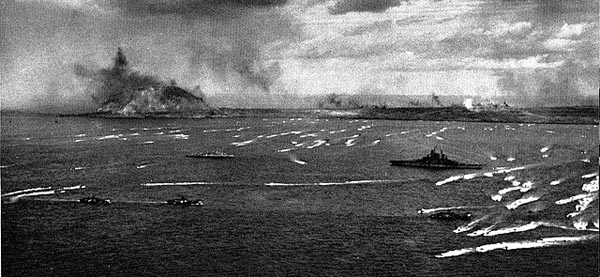
Tenneessee off Iwo Jima with the invasion fleet
Iwo Jima
The battleship en route transited by the Bonin Islands, and Pearl Harbor, then Saipan. She met the bombardment forces under order of Rear Admiral William Blandy. The latter arrived off Iwo Jima on 16 February, dispersed to take their repective firing positions. Poor visibility hampered accuracy at first, with the spotter aircraft could observe impacts. Tennessee was in charge of “cleaning up” the southeastern corner and Mount Suribachi. On 17 February, the fire was more accurate and intense. Tennessee, Idaho, and Nevada fired from 10,000 yd (9,100 m) and closed to 3,000 yd (2,700 m). Meawnoile Underwater Demolition Teams cleared beach obstacles and observed the landing zones. But they were quicly forced out by the Japanese opening fire. Tennessee took on board some of the wounded men from three of the UDT gunboats. The shelling went on until 18 February. Pillboxes, an ammunition dump were destroyed by her. Troop transports arrived with the USS North Carolina and Washington and three cruisers. They commenced together a pounding on the landing beaches followed by a carrier strike. The Marines landed at 09:00 and the battleships swapped on their secondaries to make a rolling barrage. Then, Tennessee started a close point support on demand.
This went on for two weeks, also by night undr star shells. More and more she targeted mount subarchi’s hidden Japanese guns and used telescopic sights to aim guns individually. On 7 March, Tennessee spent 1,370 main shells and 6,380 secondaries, 11,481 40 mm too. She sailed to Ulithi and prepared for the next operation, at Okinawa.

Tennessee off Iwo Jima, February 1945
Okinawa
When she arrived in Ulithi, Tennessee’s bombardment group was no under command of Rear Admiral Morton Deyo, as Task Force 54 (TF 54). He raised his mark on Tennessee on 15 March, as fagship of TF 54. It departed on 21 March to the Ryuku Islands. The group first targeted the Kerama Islands, seized to provide a base and prepare the main assault on Okinawa from a sold ground. The bombardment at that stage comprised the Colorado, Maryland, West Virginia, New Mexico, Idaho, Nevada, New York, Texas, and Arkansas, ten cruisers and thirty-two destroyers/destroyer escorts. This was the most formidable classic battlefleet of WW2. TF 54 arrived on 30 March, starting their shelling at long range, leaving time to the minesweepers to cleared the area. The next day there was a first kamikaze attack, and several waves would be repelled, more or less with success by TF 54. Tennessee was near-missed by a downed planed that first day.
Following the pre-invasion bombardment, the landing took place on 1st April and the marines faced no opposition (at first).
Lieutenant General Mitsuru Ushijima kept his troops and artillery batteries hidden in the hills as long as possible. His order was to delay the conquest of the island enough to allow kamikazes formations to be ready in the Home Islands. On 12 April, Tennessee came under attack by dive bombers, while one Aichi D3A “Val” came at lower altitude and it crashing into the signal bridge, destroying a 40 mm mount and 20 mm guns fire directors, setting the area on fire while its single 250-pound bomb penetrated the deck and exploded inside, killing 22, wounding 107.
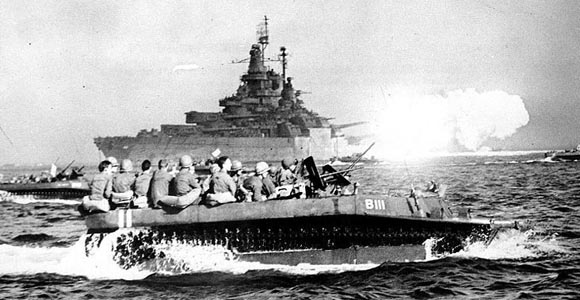
LVTs en route for Okinawa with BB 43 firing in the background. At that time her camouflage was a dark greay overall.
Tennessee and Idaho were atacked by submarines during the night, and narrowly evaded their torpedoes. Tennessee’s wounded crews were evacuated on a transport, the dead were buried at sea and she undertook emergency repairs. On 14 April she was back in action, remaining there for two weeks. Tennessee returned to Ulithi and met the repair ship Ajax there. She was back on 9 June 1945 at Okinawa, assisting in the final stage, with few kamikaze raids and the marines and soldiers “claning up” the remaining sectors, with assistane of Tennessee’s guns, until 21 June.
Oldendorf now was a vice admiral, and commander of all naval forces of Okinawa, raising his mark again on USS Tennessee as flagship. On 23 June, the battleships departed to patrol the East China Sea, preying in Japanese shipping and until 28 July assisted the raid into the Yangtze estuary off Shanghai, under cover of escort carriers. Oldendorf’s ships launched a raid on Wake Island and remained in the East China Sea until August and preparations started for the planned invasion of Japan (Operation Olympic) which never took place.
The end of USS Tennessee
The war was over and USS Tennessee still covered the landing of occupation troops at Wakayama in Japan on 23 September. She headed for Yokosuka, inspected the IJN main naval bases. On 16 October she headed for Singapore, Oldendorf transferring his mark to USS Springfield. Tennessee crossed the Indian Ocean, rounded the Cape of Good Hope, and crossed the Atlantic for the Philadelphia Navy Yard, arriving on 7 December. Indeed by now her large anti-torpedo blisters were no longer compatible with the Panama Canal. That was the time of accounts and battle honors. In all, the battleship had fired 9,347 main shells. But as the war was over, naval doctrine swapped to aircraft-carrier based task forces and she was no longer useful to the Navy. On 8 December 1945, BB 43 served with the Philadelphia Group of the Sixteenth Fleet. but with her thirty years of service the Navy decided she was useful for some more years in the reserve fleet. She was maintained in good condition and decommissioned only commenced on 14 February 1947 while she remained in reserve for twelve years before being sold on 1 March 1959, stricken and sold for scrap to Bethlehem Steel on 10 July.
USS California:
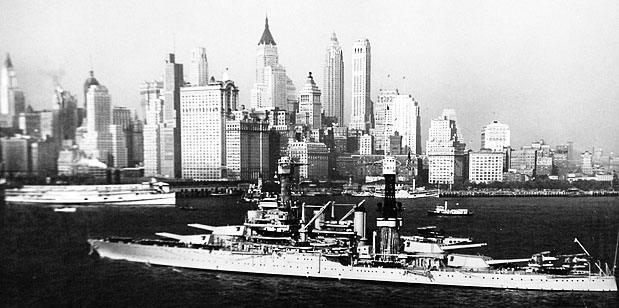
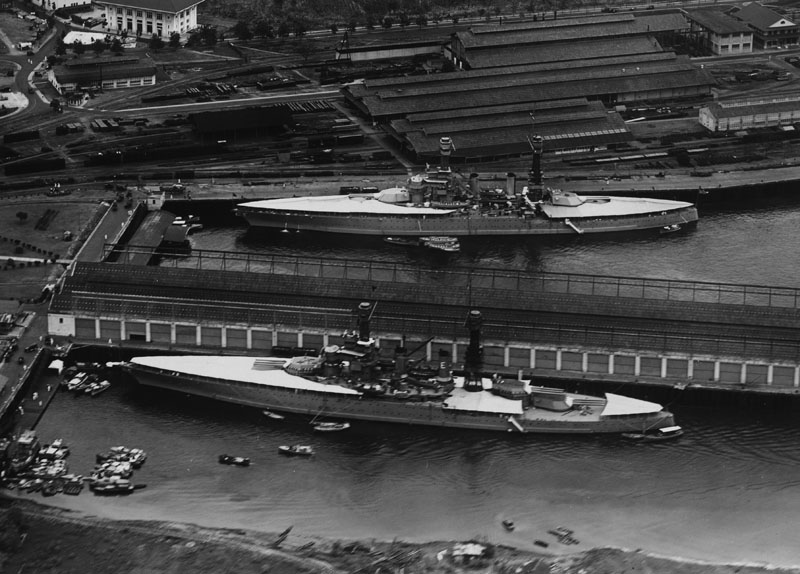
Panama Canal Zonebn, Balboa BB-43
USS California in pearl Harbor
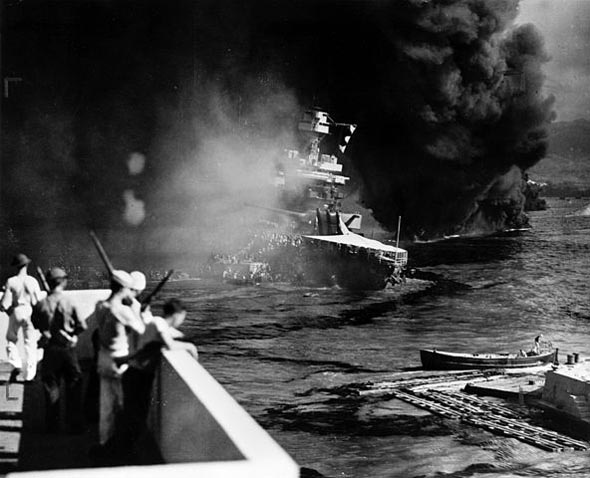
USS California and Oklahoma in the burning mist at Pearl Harbor (famous photo)
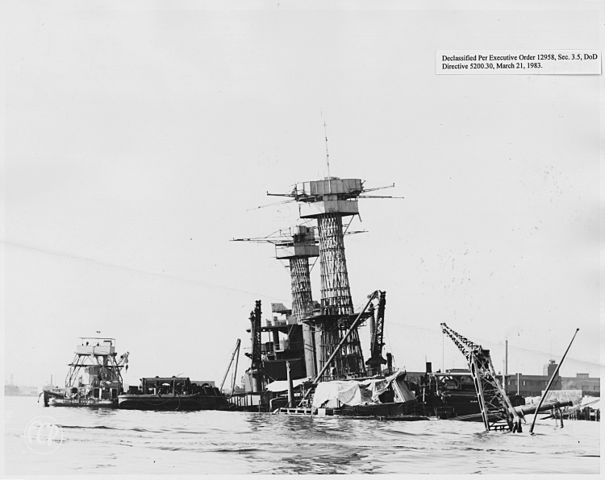
USS California salvage in January 1942
On the morning of 7 December 1941, USS California was moored on the southeastern side of Ford Island in Battleship Row. At the time, she was alone, her side vulnerable to torpedoes from which her sister ship was shielded by West Virginia. In addition she had two of her 5-inch guns and two .50-cal. machine guns ready to fire with 50 and 400 ready rounds respectively. First lieutenant Commander Marion Little, senior officer on board ordered the general quarters. All guns were prepared to action while the machines were scrambled, forcing heat to get underway as soon as possible. At 08:03, guns that were ready engaged Japanese aircraft while strafed. After expending the ready ammunition they had to reach unlock the magazine by all means (locks were not onboard). Meanwhile as the battleship became silent, two Nakajima B5N torpedo bombers approached and launched their payload, which hit the ship forward and aft. The first detonated below the armor belt (frame 52) opening a 10×24 feet gash and deforming the first torpedo bulkhead and their stiffeners, while crippling the second bulkhead. The second impact blue a 40 feet (12 m) long hole below the belt armor, but for both, interior torpedo bulkheads held on, containing the flooding.
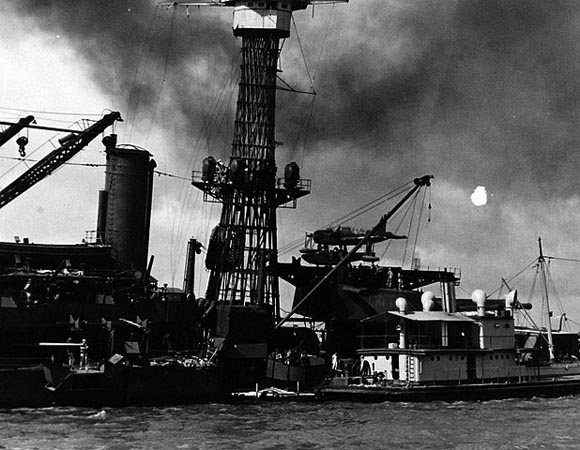
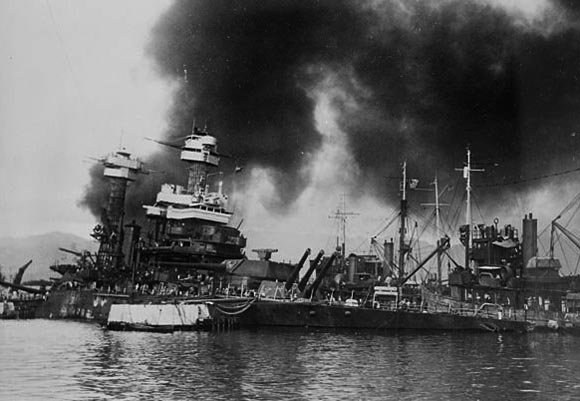
USS California in peral Harbor
As BB44 was made ready for inspection that day, all watertight doors, portholes and exterior doors were opened and the crew tried to closed them when the torpedoes hit. There was an uncontrolled flooding and she listed 5-6°. Counter-flood was ordered on the starboard side, managing to reduce it to 4 degrees, but meanwhile the port flooding spread, aggraated by the ruptured forward fuel tanks, creating a water pollution which contaminated the energy network and shut down the electrical system, therefore the pumps and lighting as well. Until 09:15, the ship was pounded by Aichi D3A dive-bombers and one hit on the starboard side. There was also a near-miss on the port side. AA gunners claimed two bombers. Commander Earl Stone at least boarded the ship at 8h45; taking command when California was struck by another modified AP bomb near the forwardmost casemate starboard. The bomb ricocheted off the second deck, detonated in the ship’s interior. The detonation kills 50 and started a fire. The boiler room crew did wonders and managed to have four of them restarted, restoring power and allowing the safety teams to do their job properly. Around 9h15, casemates No. 3, 5, and 7 were on fire; Captain Joel Bunkley and Vice Admiral William S. Pye both also boarded the California. At 10:00 smoke forced out the men the boiler room, and pumping efforts ended. After the second wave, a fire-fighting ships went alongside and battled the blaze, also pumping the water out with portable pumps. California however was filled so much she gently settled into the mud after three days of slow filling. In total, comprising the bob explosion, the crew lost that day 98 KiA and 61 wounded. Robert R. Scott (posthumously) and Gunner Jackson C. Pharris, among others was later awarded the medal of honor and Herbert C. Jones and Thomas Reeves posthumously, carrying ammunitions for the AA crews or rescuing trapped sailors.
Salvage, repairs and modernization (Dec. 1941 – January 1944)
California was less fortunate than her sister Tennessee, and salvage operations and extensive repairs meant her reconstruction was further delayed, and she returned in active service much later, in January 1944 (May 1943 for her sister ship). Salvage operations started quickly as divers patched the hull and surface crews start pumping out the water. BB 44 was finally re-floated on 25 March 1942. But on 5 April, she suffered an accidental explosion, resulting -after enquiry- to a probable mixture of fuel oil vapor and hydrogen sulfide gas. One of the patch on forward hole was blasted, and watertight doors damaged. The ship started to be flooded again, but the salvage team worked out this for two days, re-patching her. On 9 April, she was towed to Dry Dock No. 2 for initial repairs. She was made floatable on 9 June but stayed idle, pending her fate, until 10 October. She departed for Pudget Sound, escorted by the destroyer USS Gansevoort. This extensive work (see the details above) lasted from 20 October 1942 to 31 January 1944. Contrary to her sister ships, she had a CXAM radar, which was now obsolete, removed and installed on Oahu. She received modern radar and electronics ad her crew swelled. She made post-reconstruction trials at San pedro, and a shakedown cruise. She started anew, with a young inexperienced crew, and so a long training session commenced. She would receive another short overhaul in San Francisco, and machinery overhaul and by 5 May 1944, she departed to join the fleet assembling in the central Pacific.
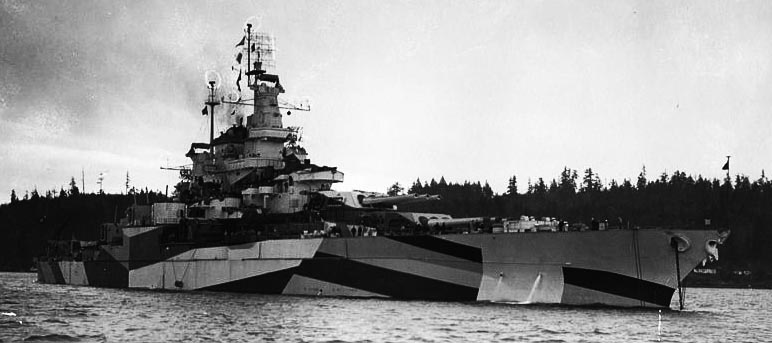
USS Califoria, January 1944
The Marianas Campaign
After stopping in pearl Harbor on her way to the Marianas, she made some bombardment practice off Kahoolawe. She departed on 31 May for Roi-Namur in the Marshalls, arriving on 8 June, and joined Task Group (TG) 52.17, the Fire Support Group 1 (Rear Admiral Jesse B. Oldendorf). She started to bombard Saipan on 14 June in the morning, helped by her spotting aircraft, at 14,500 yards (13,300 m). She shelled in particular the defended area around the capital, Garapan. She also took a Japanese 4.7-inch (120 mm) field gun shell aft of the fire control platform, which killed one, injured four, and disabled her air search radar. She would, as future missions of the kind, retired for the night. At some point she engaged a group of Japanese Type 95 and Type 97 tanks in Garapan, spotted by her planes, destroying at least one. She also silenced the Mañagaha island battery, which engaged USS Maryland. From 15 June, she covered and assisted the 2nd Marine Division went ashore and California supported the assault, opening fire at 06:12, first at Garapan and then at the landing beaches as dug-in defenders attempted to repel the landing. The ship also assault on Afetna Point. She also repelled night time counterattacks via radio. The 17, she shared a victory with Maryland on a Kawasaki Ki-61 fighter. She left on 22 June replenish at Eniwetok.
She also underwent repairs there from 25 June to 16 July. Back to Saipan she was informed the sector has been secured. So she was prepared to attack Guam (Operation Stevedore). She arrived in the Marianas, joining Tennessee and four destroyers as Task Unit 53.1.16, off Guam on 19 July. She started a preparatory bombardment and until 21 July, swapping on close cover fire, notably on Tumon and Agana areas. She later left for resupply at Saipan and later proceeded to Tinian. Bombardment commenced there on 23 July, around San Jose (southern sector) as a diversion. She later supported the landings to the north. The town was levelled. USS California later patrolled off the island, shelling Japanese forces which were signalled along the way. She participated in supressing the Japanese last stand on 31 July and later departed to Guam, for more fire support as the island was still not secured, until 9 August. Then she left to resupply at Eniwetok.
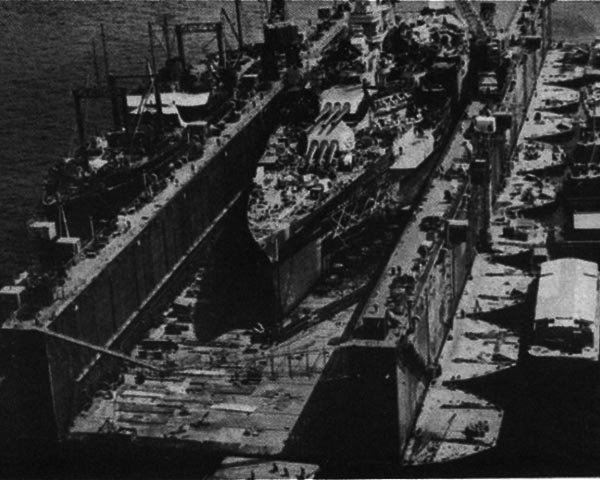
California in drydock USS Artisan AFDB-1
The Philippines Campaign
On 19 August, California departed Eniwetok for Espiritu Santo but on 23 August, Tennessee suffered a steering malfunction, she left the line, turned towards to, and collide with, USS California. Her own bow was badly damaged and seven crewmen died in the accident, others left trapped in their berthing compartment compressed by bent bulkheads. Damage control teams repaired the ship while Tennessee had to leave for Pearl Harbor. California continued and upon arrival, entered the floating drydock USS Artisan for repairs. This went on until 10 September 1944 and she missed the assault on Peleliu. But she was ready for the onslaught on the Philippines.
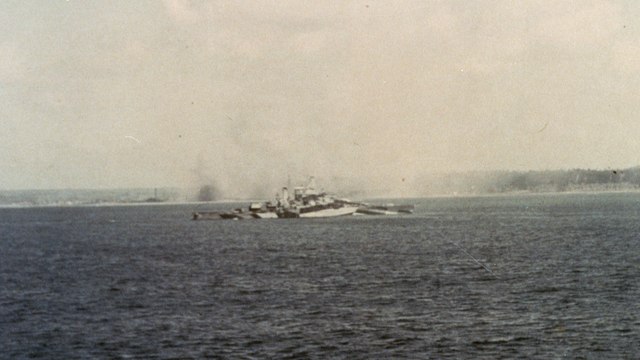
USS California left Espiritu Santo on 17 September, sailed along New Guinea, and arrived in Manus on 22 September. USS California was part of Oldendorf’s bombardment group with Maryland, Mississippi, Pennsylvania, Tennessee, and West Virginia. They departed on 12 October for the Philippines, and the campaign started five days later. On 19 October, she started bombarding the island and the next day, repealed two kamikazes. When allied reconnaissance aircraft and submarines reported a Japanese fleet approaching from the south, the bombardment group was scrambled to southern Leyte and headed for the Surigao Strait. At 03:12, USS California’s SG radar picked up Japanese ships at 42,200 yards (38,600 m). Eight minutes later it was her forward Mk 8 fire control radar which was tracking the ships, at 38,000 yards (35,000 m). USS West Virginia was the first to open fire, at 03:52. California fired at 20,400 yards (18,700 m), with a six-gun salvo to spare ammunitions. The American battle line was order to turned about, but USS California’s misinterpreted the “turn one five” order and near-missed her sister, as she turned 15 degrees instead of 150 as indicated. She almost percuted Tennessee’s bow for the second time. Burnett ordered a hard starboard turn and Tennessee’s captain, also seeing what happened, maintained his ship in the line. Tennessee was blocked from firing for several minutes. California had a misfire in the right gun, Y turret. The concussion disabled the rear Mk 8 radar, damaged the scope of the forward radar. She stopped a few minutes later after expending 63 shells.
Meanwhile, Vice Admiral Takeo Kurita crossed the San Bernardino Strait and on 25 October fell on Taffy 3, leading to the Battle off Samar. Rear Admiral Clifton Sprague sent an urgent calls for help and Oldendorf immediately scrambled his ships northward, finding off an air attack en route. By the time they arrived however, the splendid defense had repelled Kurita already, and the the bombardment group resumed ground support operations, until the Battle of Lingayen Gulf.
On 20 November, California stopped at Manus island for repairs in a floating drydock, until 15 December 1944. She proceeded to the Kossol Roads (Palau), until 1 January 1945 and then the Leyte Gulf, joining the bombardment group to western Luzon. They supported the main assault in the Lingayen Gulf and were attacked by waves of Japanese aircraft en route. California was not damaged but failed to down any plane. On 5 January Olderndorf’s group entered the gulf, floatplanes were out to search for targets. First, California fired on Santiago Island, western side of the gulf, to destroy a Japanese battery. After the minesweepers swept channels, California take her positions as flagship, Oldendorf being aboard. At 17:15 two Zero kamikazes aimed USS California but her guners shot one, the other stricking her on the port side, abreast of the mainmast. A fire started. Also a freindly 5-inch shell landed on one of her 5-inch guns, exploding inside the turret. Both fires were suppressed in 12 minutes but the attack left 44 Kia, 155 injured. Durng the next bombardment days she was repaired as best the team could. On January 10, USS California left the gulf and patrolled the South China Sea to fend off any counterattack. She was back on the 18, but departed again on the 22 for Ulithi and from there, to Pearl Harbor, arriving on 6 February.
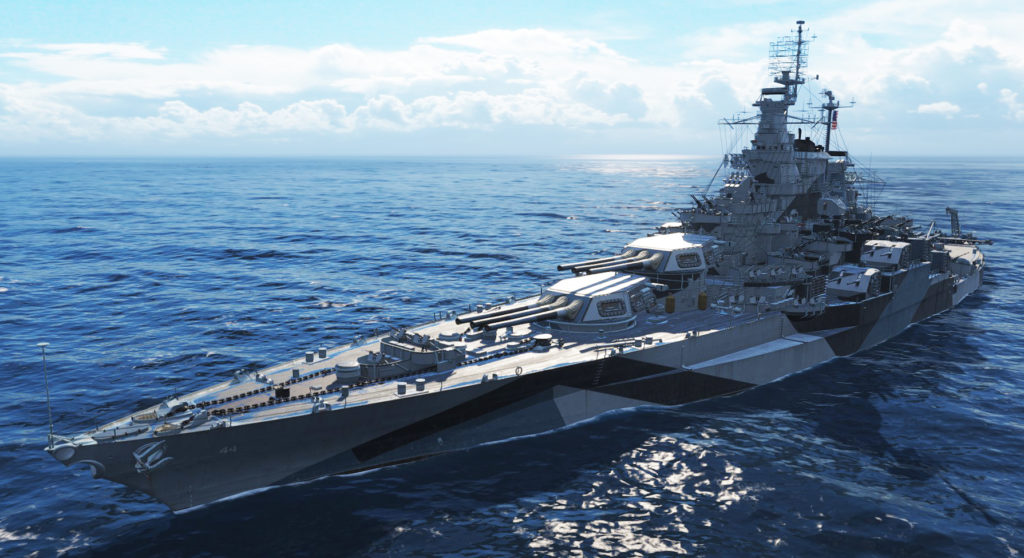
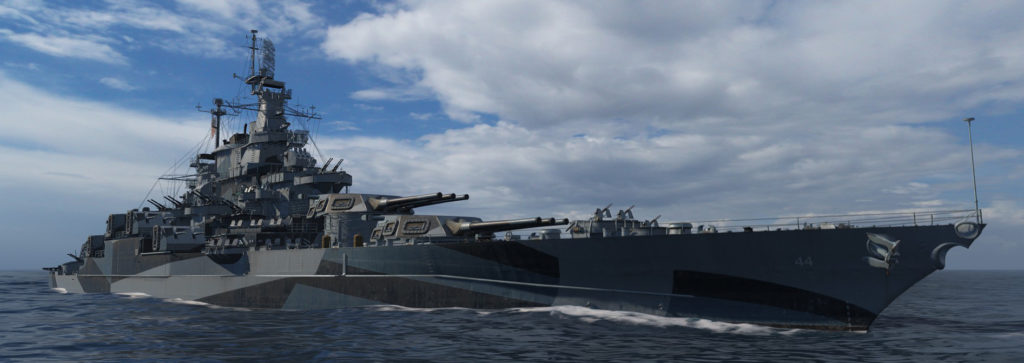
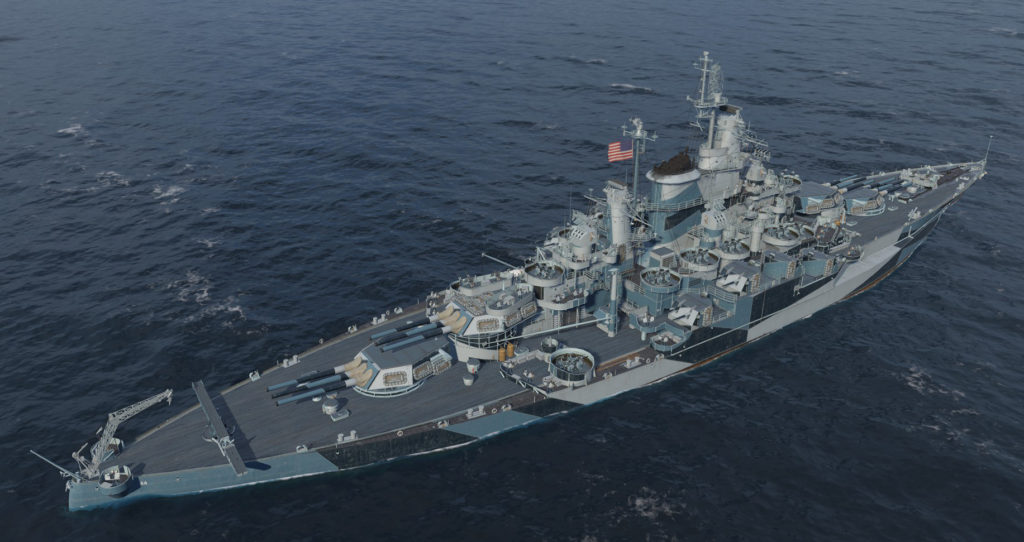
WoW’s renditions of the USS California in 1944
Okinawa and Japan (June-September 1945)
She then departed again two days later for Puget Sound. On 24 April, she departed after remairs and upgrades, and proceeded to make her post-refit trials, then headed for Long Beach on 29 April. On 2 -10 May 1945, she had another refit, and made a shakedown cruise. On 10 May she departed to join the fleet at on Okinawa, stopped in Pearl Harbor en route and Ulithi until 12 June. But at that stage the battle was nearly over. On 15 June,she arrived off okinawa, just after a massive kamikaze attack, but she would fend off others. On 17-18 June she teamed with the heavy cruisers New Orleans and Tuscaloosa to shell Yaesu-Dake and Yuza-Dake ridges on behalf of the 96th Infantry Division for two days. She patrolled off the island until 14 July and until 22 July was posted at Kerama Rettō to replenish. She joined Task Force 95 sent into the East China Sea, protecting operating minelayers. On 8 August she left TF 95 for maintenance at San Pedro Bay in the Philippines, and emerged from there on 15 August.
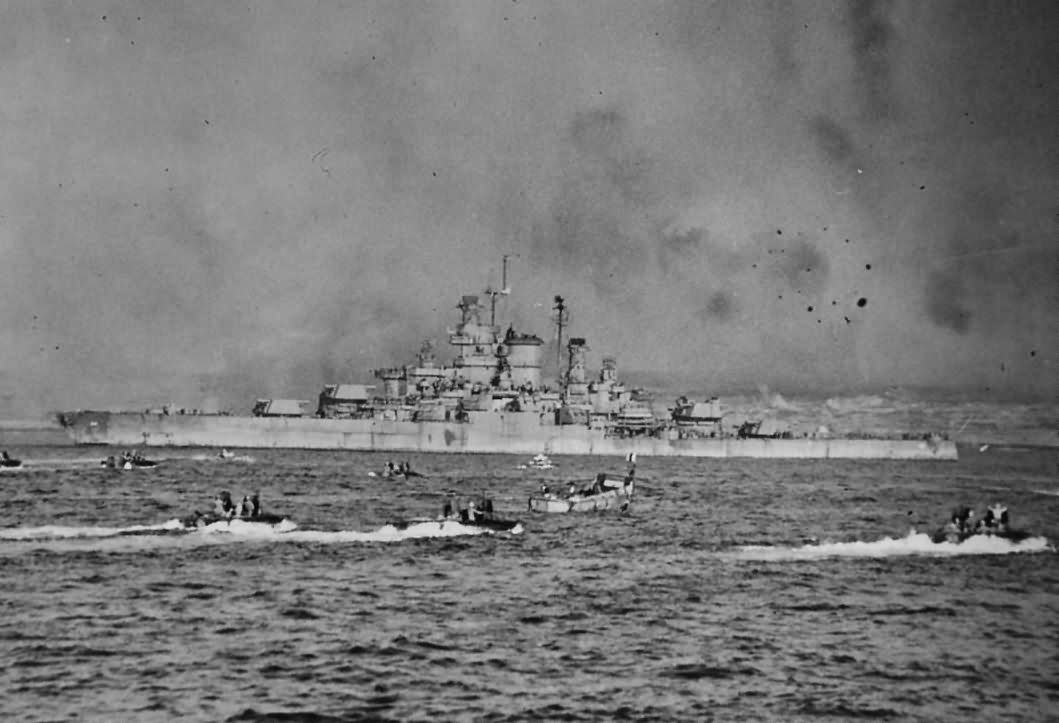
U.S.S. Tennessee shelling Iwo Jima.
But at that stage, the Japanese surrendered; she steamed to Nakagusuku Bay, Okinawa, remaining until 20 September and awaiting orders. She proceeded to Wakayama, arriving on 23 September to support the Sixth Army troops starting its occupation of Japan. She arrived later in Yokosuka on 3 October, dropping anchors near IJN Nagato. She was ordere to join Task Group 50.5, and her sister-ship to proceede back home. Departed Japan on 15 October, they stopped in Singapore, crossed Strait of Malacca and Indian Ocean, stopped in Colombo to pickup South African troops, stopped in Cape Town, and steamed into the Atlantic, stopping in Saint Helena and Ascension Island and reaching Philadelphia on 7 December 1945. Her crew was discharged as she was laid up, formally placed in reserve but commissioned on 7 August 1946. Full decommission followed on 14 February 1947 but she was still not stricken for a decade, until 1 March 1959, sold for BU to the Bethlehem Shipbuilding Corporation in July.
An article started by TimberWolfMGS, rewritten and completed by dreadnaughtz666 (The captain)

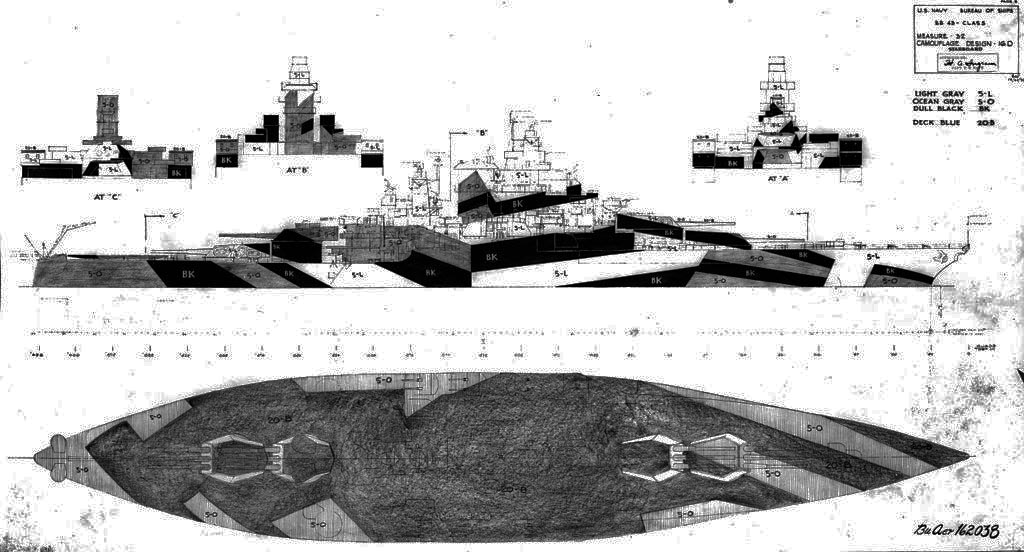
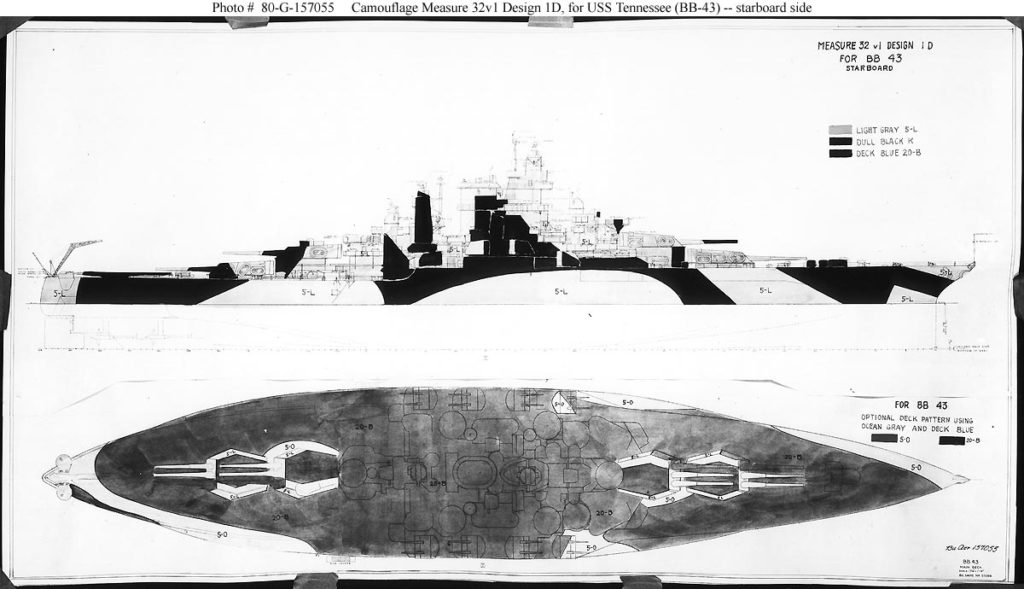
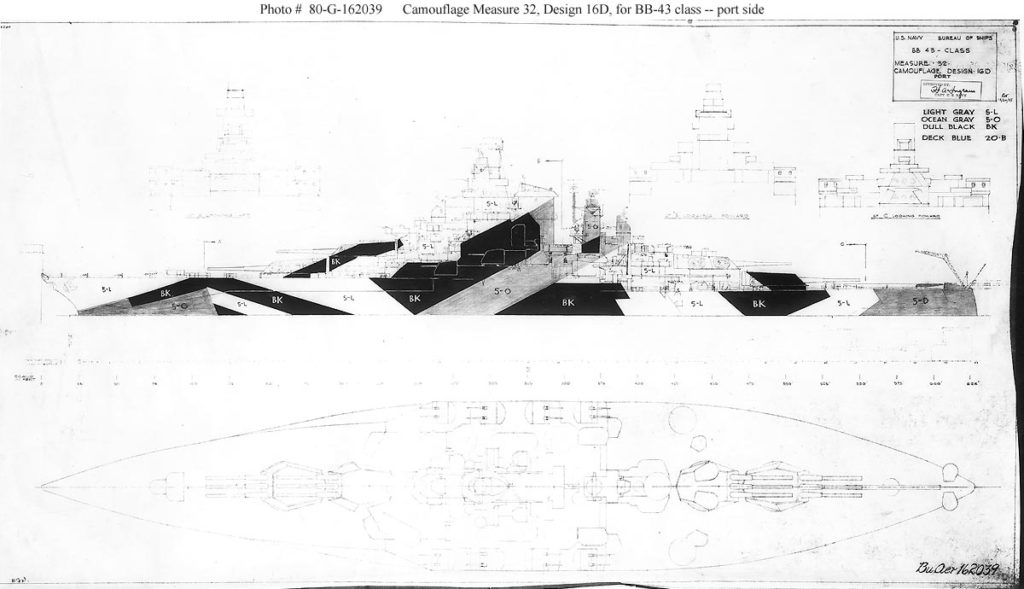
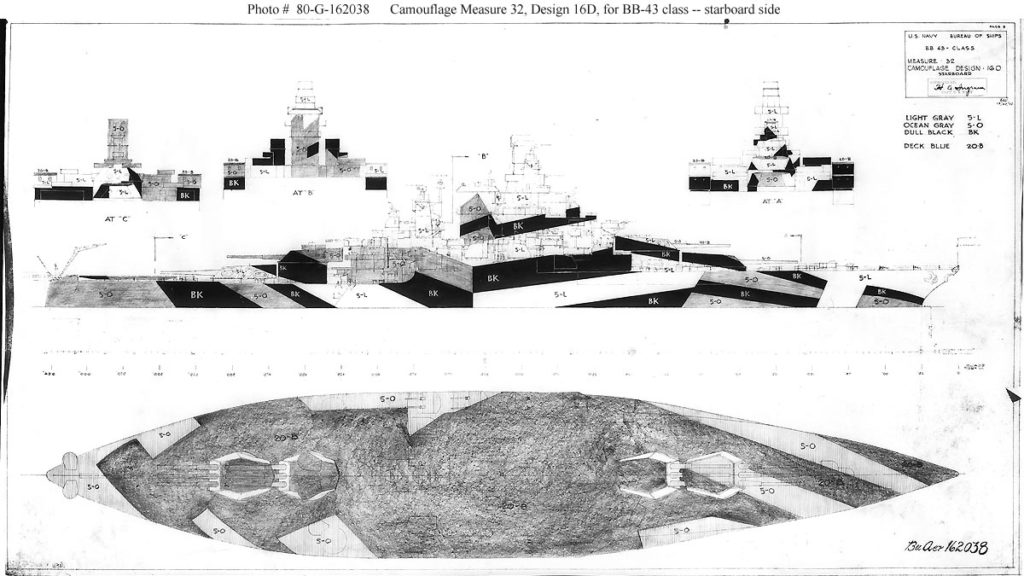

 Latest Facebook Entry -
Latest Facebook Entry -  X(Tweeter) Naval Encyclopedia's deck archive
X(Tweeter) Naval Encyclopedia's deck archive Instagram (@navalencyc)
Instagram (@navalencyc)





 French Navy
French Navy Royal Navy
Royal Navy Russian Navy
Russian Navy Armada Espanola
Armada Espanola Austrian Navy
Austrian Navy K.u.K. Kriegsmarine
K.u.K. Kriegsmarine Dansk Marine
Dansk Marine Nautiko Hellenon
Nautiko Hellenon Koninklije Marine 1870
Koninklije Marine 1870 Marinha do Brasil
Marinha do Brasil Osmanlı Donanması
Osmanlı Donanması Marina Do Peru
Marina Do Peru Marinha do Portugal
Marinha do Portugal Regia Marina 1870
Regia Marina 1870 Nihhon Kaigun 1870
Nihhon Kaigun 1870 Preußische Marine 1870
Preußische Marine 1870 Russkiy Flot 1870
Russkiy Flot 1870 Svenska marinen
Svenska marinen Søværnet
Søværnet Union Navy
Union Navy Confederate Navy
Confederate Navy Armada de Argentina
Armada de Argentina Imperial Chinese Navy
Imperial Chinese Navy Marinha do Portugal
Marinha do Portugal Mexico
Mexico Kaiserliche Marine
Kaiserliche Marine 1898 US Navy
1898 US Navy Sovietskiy Flot
Sovietskiy Flot Royal Canadian Navy
Royal Canadian Navy Royal Australian Navy
Royal Australian Navy RNZN Fleet
RNZN Fleet Chinese Navy 1937
Chinese Navy 1937 Kriegsmarine
Kriegsmarine Chilean Navy
Chilean Navy Danish Navy
Danish Navy Finnish Navy
Finnish Navy Hellenic Navy
Hellenic Navy Polish Navy
Polish Navy Romanian Navy
Romanian Navy Turkish Navy
Turkish Navy Royal Yugoslav Navy
Royal Yugoslav Navy Royal Thai Navy
Royal Thai Navy Minor Navies
Minor Navies Albania
Albania Austria
Austria Belgium
Belgium Columbia
Columbia Costa Rica
Costa Rica Cuba
Cuba Czechoslovakia
Czechoslovakia Dominican Republic
Dominican Republic Haiti
Haiti Hungary
Hungary Honduras
Honduras Estonia
Estonia Iceland
Iceland Eire
Eire Equador
Equador Iran
Iran Iraq
Iraq Latvia
Latvia Liberia
Liberia Lithuania
Lithuania Mandchukuo
Mandchukuo Morocco
Morocco Nicaragua
Nicaragua Persia
Persia San Salvador
San Salvador Sarawak
Sarawak Uruguay
Uruguay Venezuela
Venezuela Zanzibar
Zanzibar Warsaw Pact Navies
Warsaw Pact Navies Bulgaria
Bulgaria Hungary
Hungary

 Bundesmarine
Bundesmarine Dutch Navy
Dutch Navy Hellenic Navy
Hellenic Navy Marina Militare
Marina Militare Yugoslav Navy
Yugoslav Navy Chinese Navy
Chinese Navy Indian Navy
Indian Navy Indonesian Navy
Indonesian Navy JMSDF
JMSDF North Korean Navy
North Korean Navy Pakistani Navy
Pakistani Navy Philippines Navy
Philippines Navy ROKN
ROKN Rep. of Singapore Navy
Rep. of Singapore Navy Taiwanese Navy
Taiwanese Navy IDF Navy
IDF Navy Saudi Navy
Saudi Navy Royal New Zealand Navy
Royal New Zealand Navy Egyptian Navy
Egyptian Navy South African Navy
South African Navy






























 Ukrainian Navy
Ukrainian Navy dbodesign
dbodesign